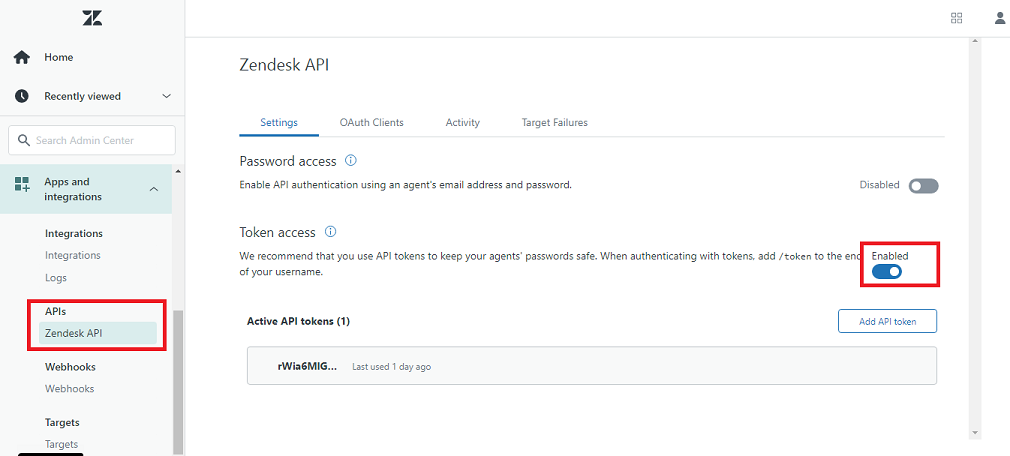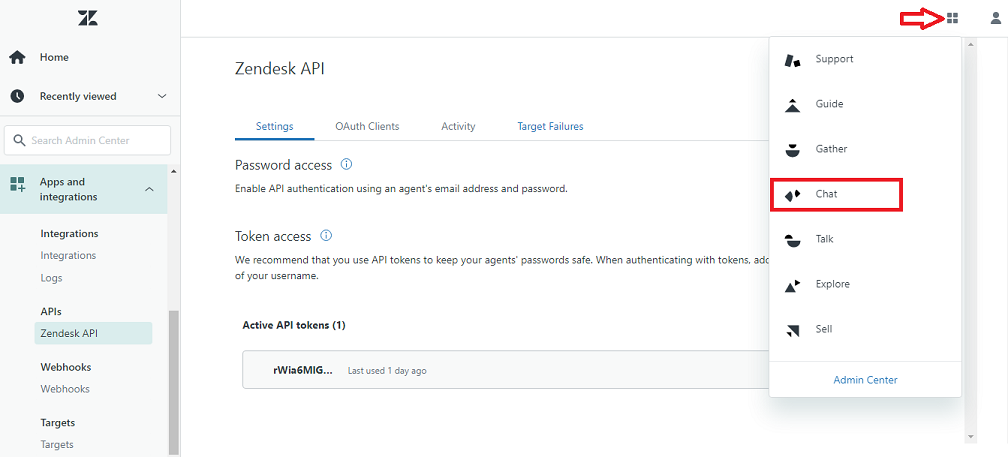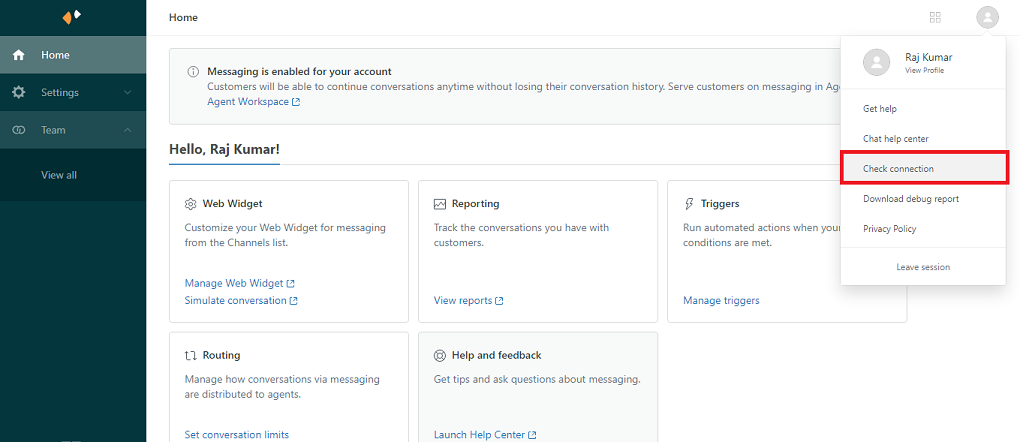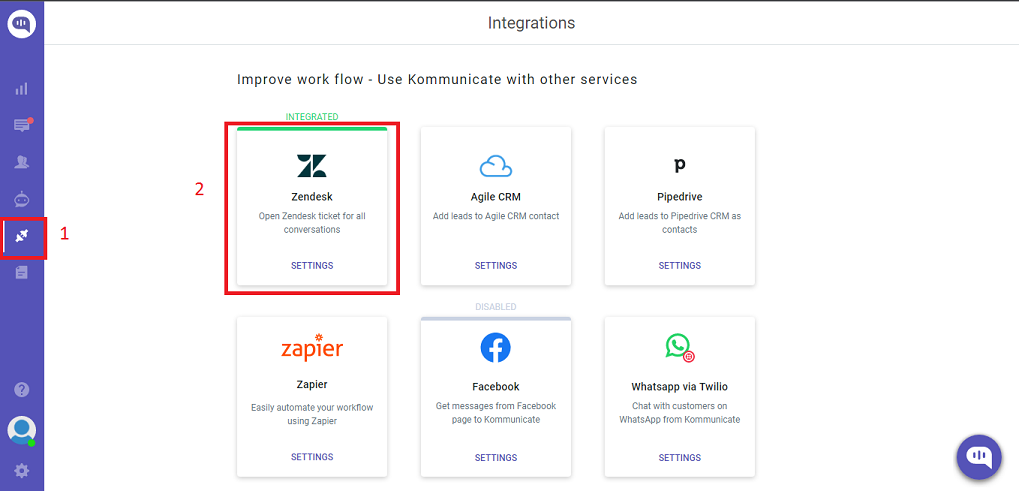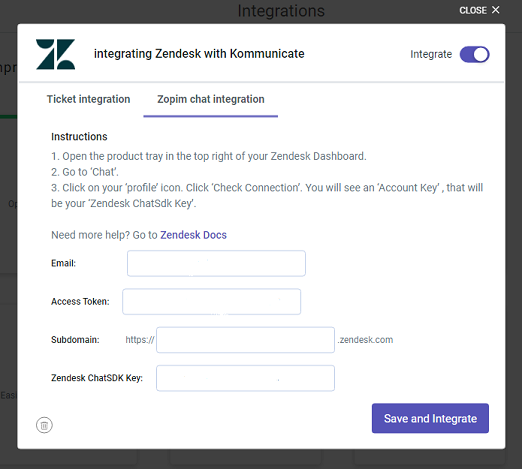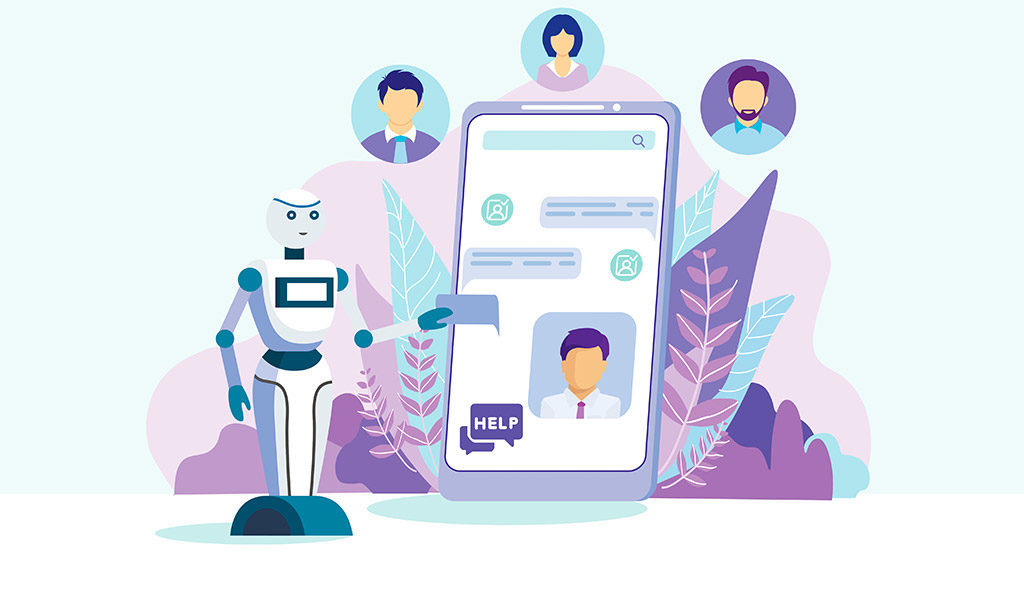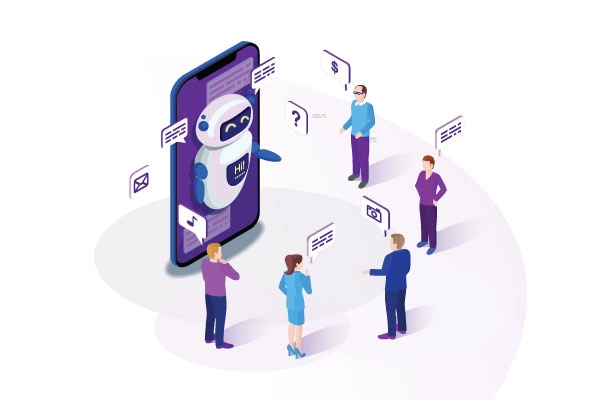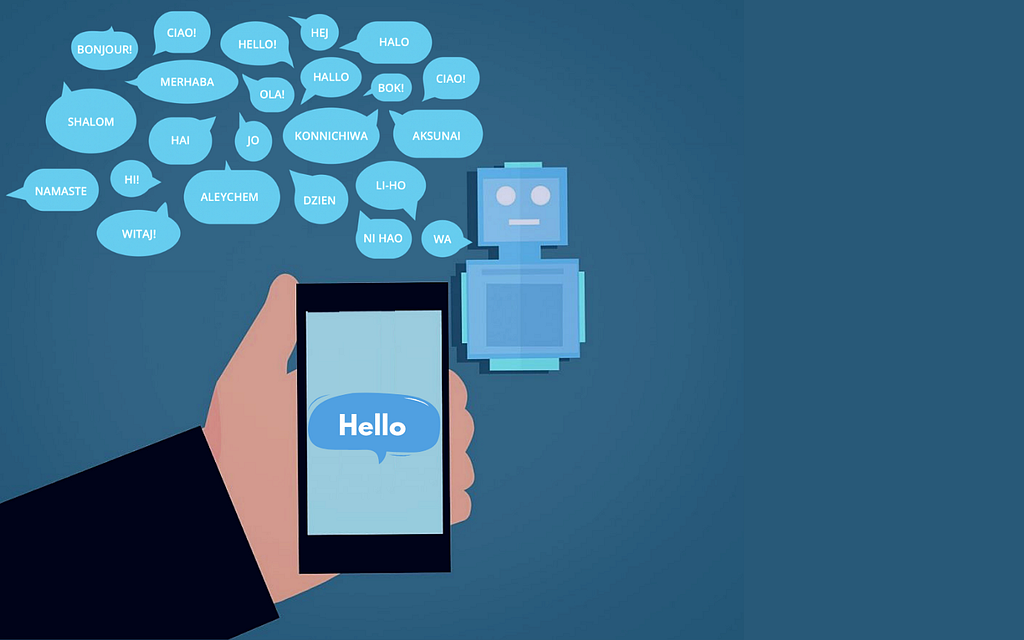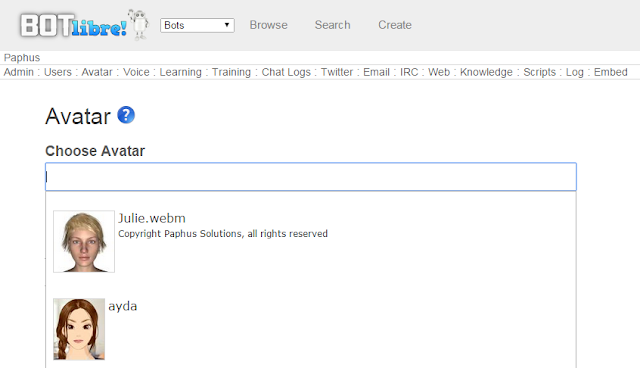Your cart is currently empty!
Month: May 2022
-
How To Get The Most Out Of Your Facebook — Add A Chatbot
How To Get The Most Out Of Your Facebook — Add A Chatbot
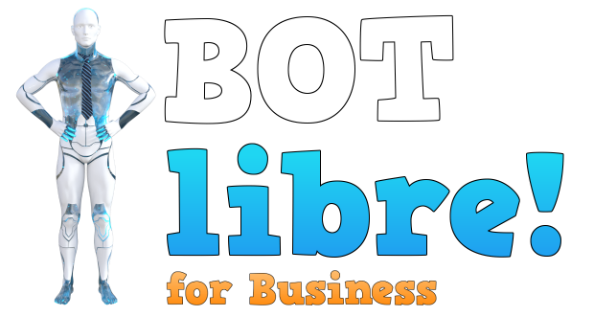
Keeping up with social media and keeping your online community engaged can be a time-consuming task. Through Bot Libre you can now automate your Facebook presence with your own Facebook Messenger bot. Any Bot Libre bot can be connected to a Facebook Messenger page account. The bot will reply to your users’ questions in real-time using the responses of the script you have trained your bot with.
Connecting a bot to Facebook is a bit of a process, as Facebook requires a lot of permissions and validation to be set up to allow a bot on their platform. This “how-to” gives you a step-by-step process to connect your bot to Facebook Messenger.
You can also watch this video on How to create a chatbot for Facebook Messenger over here.
Step 1: Create A Facebook Page For Your Bot
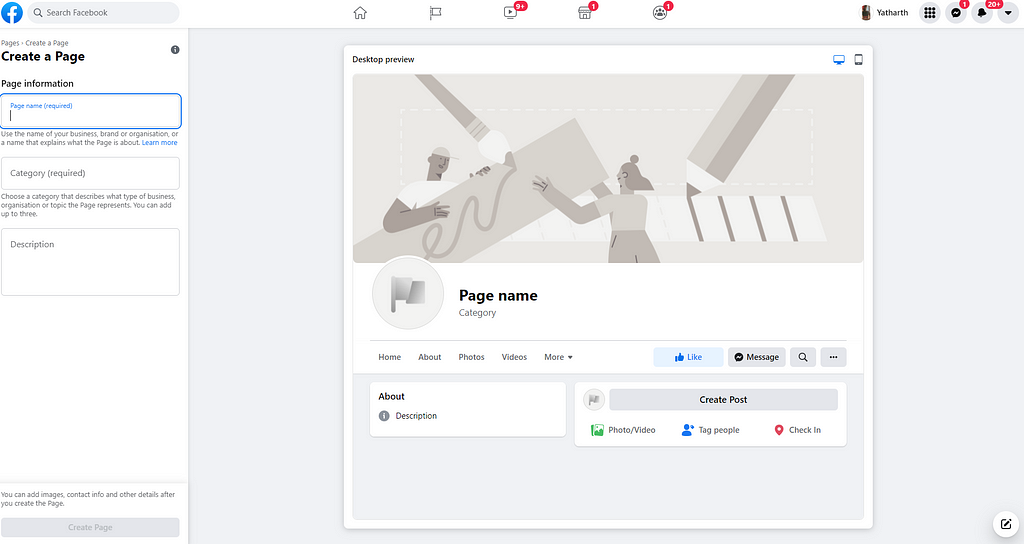
You must then select a category for your page. Choose a category that will make sense for your bot.
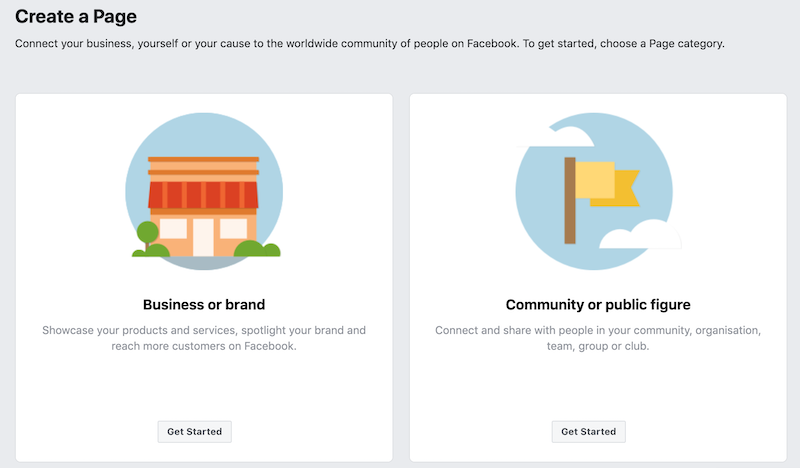
Fill out the details for your page to finish creating it.
Step 2: Create A Facebook App For Your Bot
Go to http://developers.facebook.com and click on ‘Get Started’.

Click the ‘Next’ button to continue.
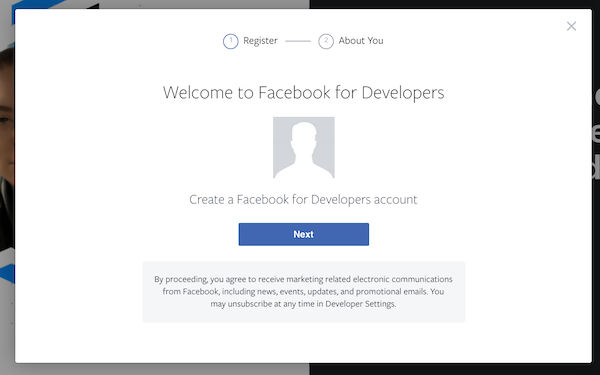
Select the best option to describe yourself on the following screen. Now click on the ‘Create First App’ button.
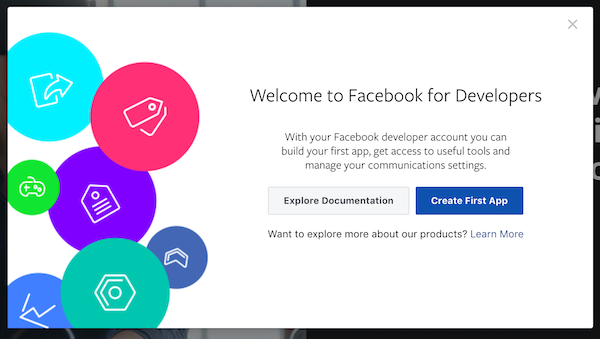
Next, enter a Display Name and then click the ‘Create App ID’ button.
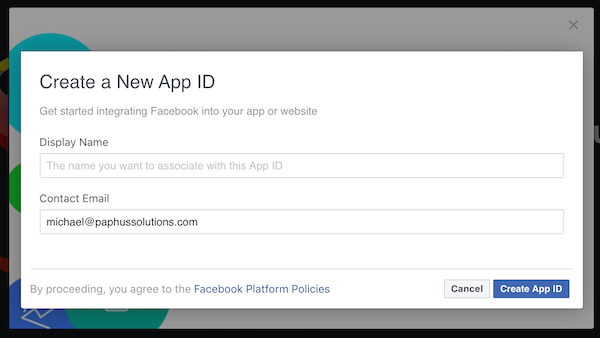
On the following screen, click ‘Settings’ in the left toolbar then select ‘Basic’.

Enter “https://www.botlibre.com” into the ‘App Domains’ field. Note your App ID and App Secret, you will need these in following steps.
Scroll to the bottom of this screen and click the ‘+ Add Platform’ button.

Select ‘Website’ from the following popup window.
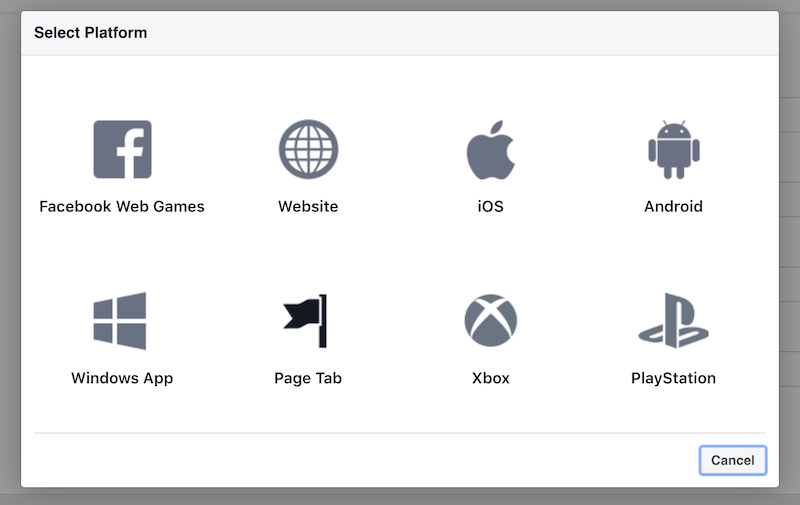
Just two more steps to go and you’ve added a bot to your website!
Enter “https://www.botlibre.com” into the ‘Site URL’ field.

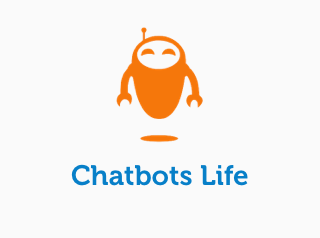
Chatbots Life Click the ‘Save Changes’ button.
Next, click on ‘Facebook Login’ in the left toolbar, then select ‘Settings.’
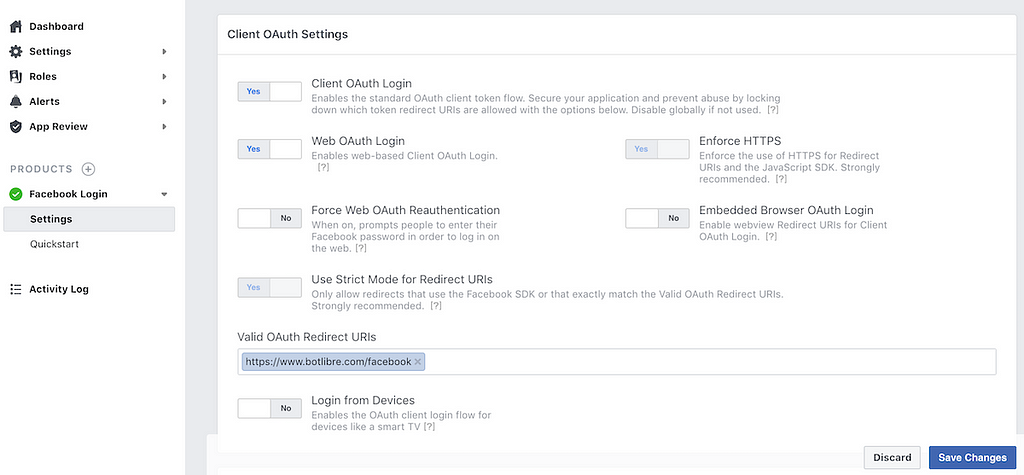
Enter “https://www.botlibre.com/facebook” into the ‘Valid OAuth Redirect URIs’ field then click the ‘Save Changes’ button.
Step 3 — Create a bot
Next, you will need to create a bot to connect with your Facebook Page and App. You can follow the instructions here to create your bot: How to create your own chat bot in 10 clicks
Step 4 — Connect bot with Facebook
From the Bot Libre website, browse to your bot. Go to the Admin Console by clicking on the gear icon at the bottom.

From the Admin Console, click on “Facebook” to take you to a screen to configure your Facebook settings.
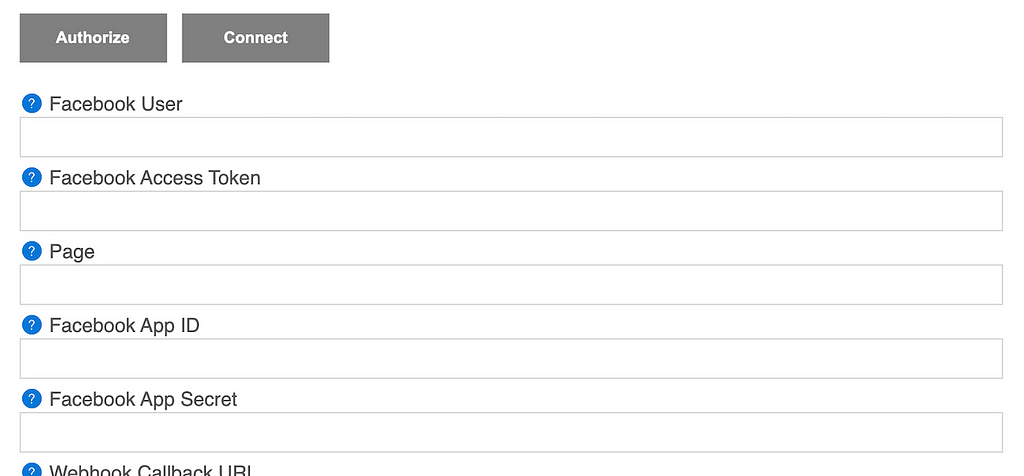
Enter the ‘App ID” and “App Secret’ from your Facebook App into the corresponding fields on this form.
Next, click the ‘Authorize’ button to authorize your bot with Facebook. Click ‘Okay’ to accept any permissions needed by Facebook.
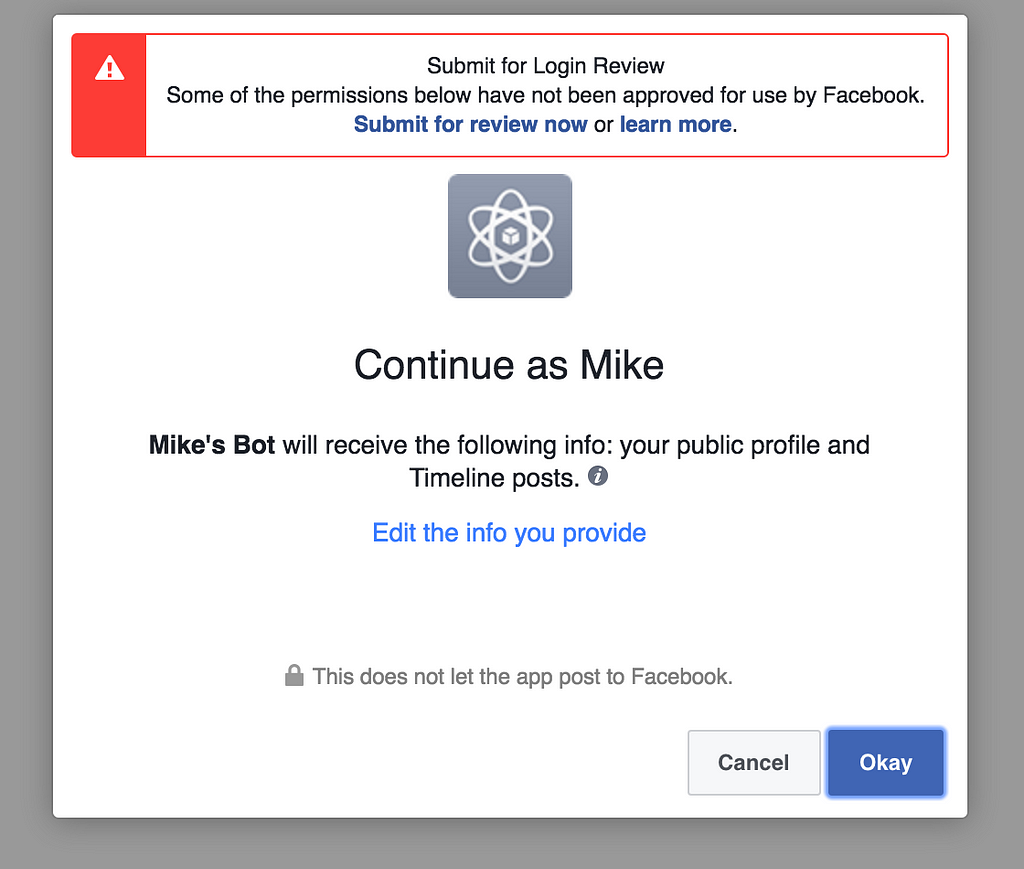
Select the checkbox for the page you created in step 1, then click the ‘Next’ button.
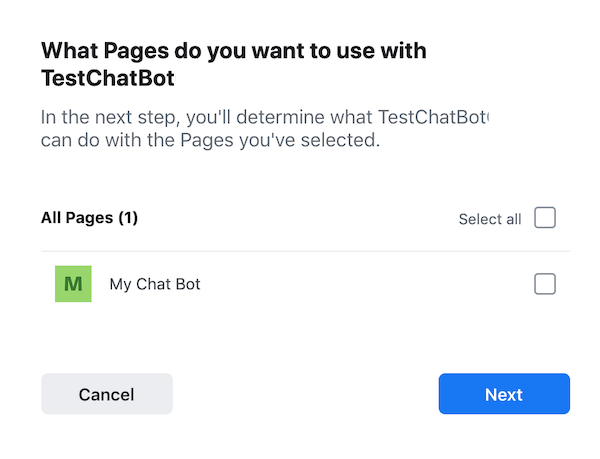
Select ‘Yes’ for the requested permissions in the following screen.
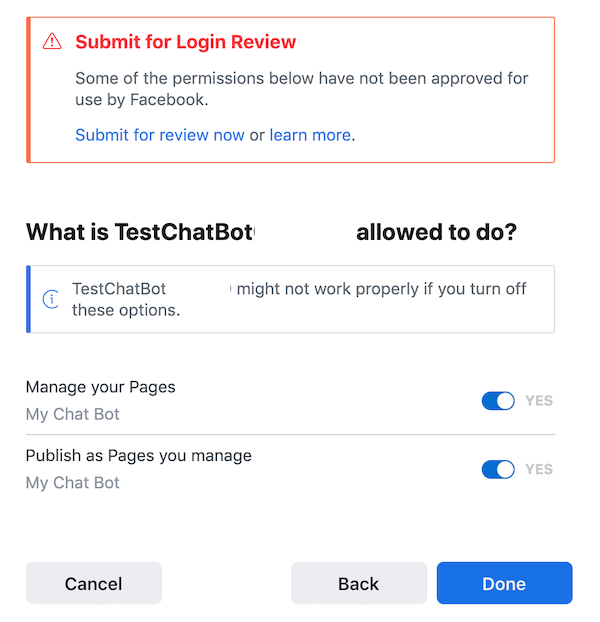
Click ‘Done’ when finished.
The “Facebook User”, “Access Token” and “Page” fields should now have been filled in automatically.
Click the “Connect” button to connect your bot to Facebook.
Now scroll down to “Facebook Messenger Properties” and click “Facebook Messenger app (realtime messages)” to toggle it on. Press save.

Copy the “Webhook URL” to your clipboard for use in the next step.
Step 5 — Set up Webhook URL with Facebook
Go to your Facebook App’s dashboard webpage. Click on ‘Products +’ in the left menu.
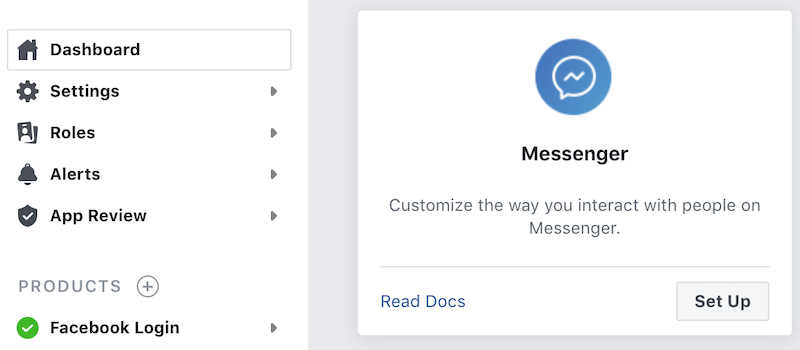
Next, click the ‘Set Up’ button in the ‘Messenger’ panel.
Now select ‘Settings’ under ‘Messenger’ in the left menu.

Click the ‘Add Callback URL’ button.
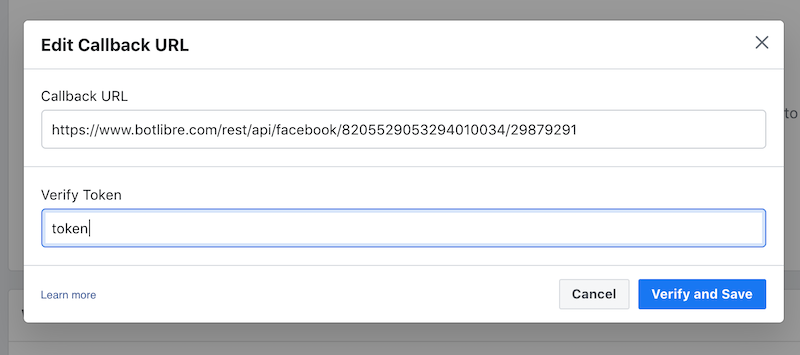
Enter the ‘Webhook URL’ you had copied in the previous step into the ‘Callback URL’ field. Enter “token” into the ‘Verify Token’ field.
Click the “Verify and Save” button to finish.
The following window will pop up, select the checkbox next to your page and press the ‘Next’ button.
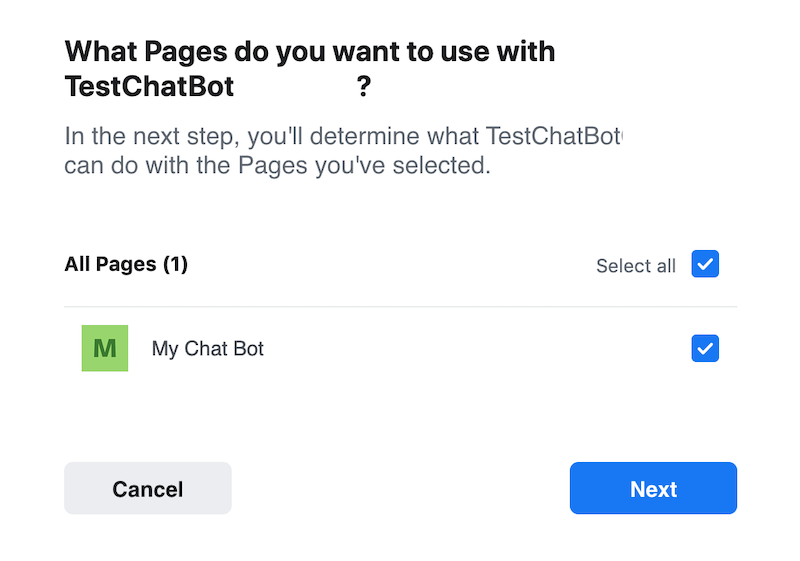
In the following window, check the box for ‘Manage and access Page conversations on Messenger’.
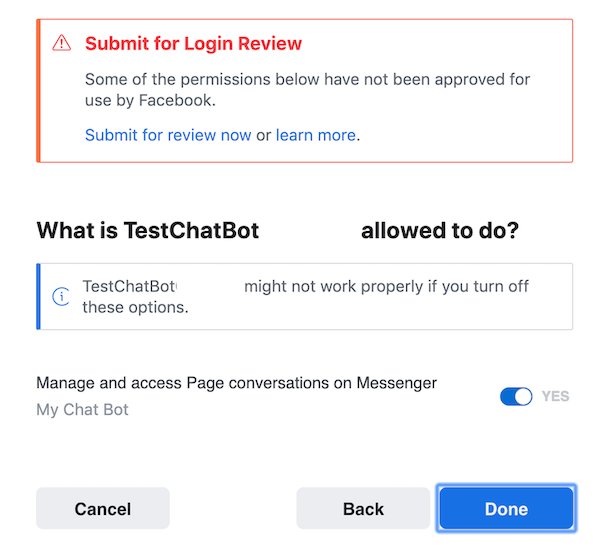
Press the ‘Done’ button. On the dashboard below, click the ‘Add Subscriptions’ button next to your page.
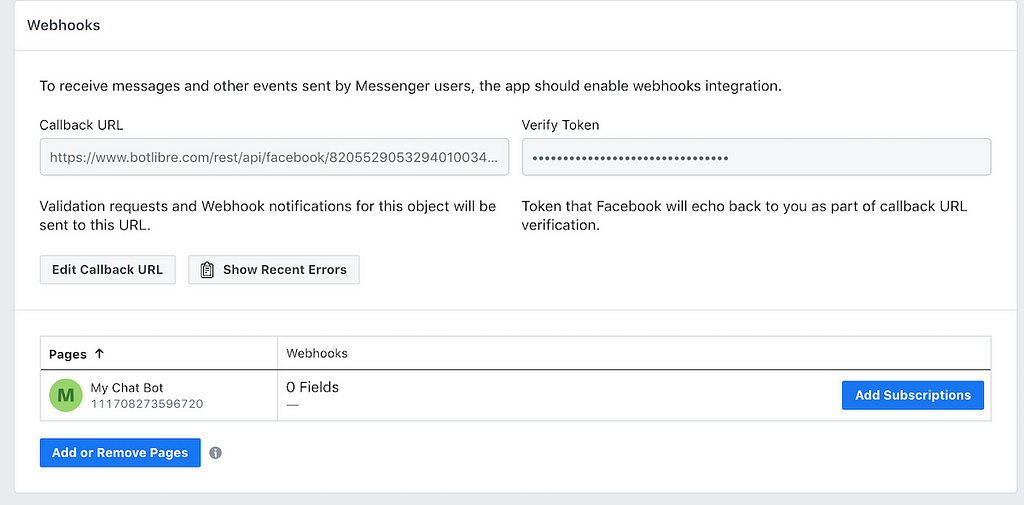
Select the ‘messages’ checkbox in the following window.
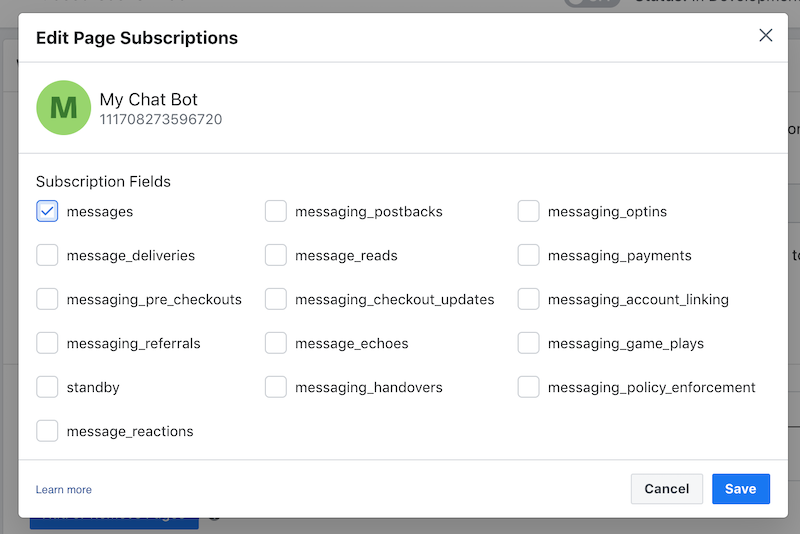
Click the ‘Save’ button. Scroll to the ‘Access Tokens’ section of the Messenger Settings page.
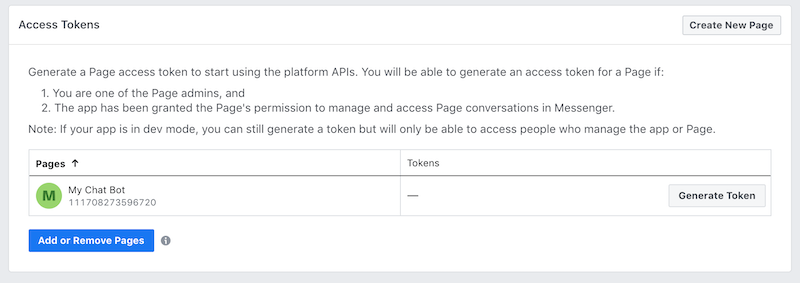
Click the ‘Generate Token’ button next to your bot’s Facebook page.
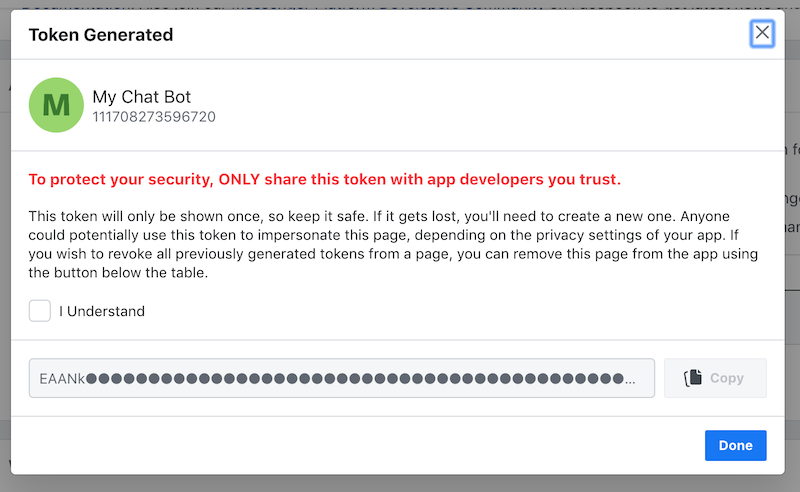
Click the ‘I Understand’ checkbox, then copy the token to your clipboard by clicking the ‘Copy’ button. Click the ‘Done’ button to close the window.
Now return to your bot’s Admin Console on the Bot Libre website. Go to the ‘Facebook’ tab and paste the ‘Page Access Token’ you had previously copied into the “Facebook Messenger Page Access Token” field.

Click the ‘Save’ button.
Step 6 — Approval by Facebook
At this point, you should be able to send messages to your bot’s Facebook Page with the Facebook user who created the page, and your bot will respond.
For other Facebook users to be able to send and receive messages with your bot, you will need to have your Facebook App approved by Facebook.
Return to the Messenger Settings page on the Facebook Developer website and scroll to the ‘App Review for Messenger’ section.
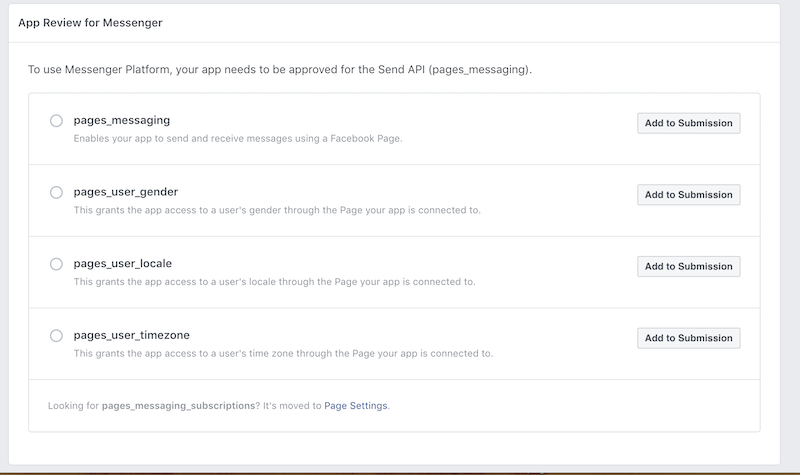
Click the ‘Add to Submission’ buttons next to the four permissions.
You may need to complete additional details in the “App Details” tab before you can complete your submission. You will need to upload an app logo and provide a URL to your privacy policy.
You will also need to complete business or individual verification. This can be found on the ‘Messenger Settings’ page.

After receiving your verification information, Facebook should approve your App after some time.
Toggle the ‘Off’ switch to ‘On’ at the top of the Facebook Developer page to make your app available to the public and have other users be able to interact with your bot.
If you got this far, congratulations, you have created a bot for Facebook Messenger for FREE. Now you can train your bot’s responses and review its conversations from its “Training & Chat Logs” page in its Admin Console.
If you’re having any issues or would like our help setting up your bot, please email us at support@botlibre.com or upgrade to our Platinum service at sales@botlibre.biz and we can build your bot for you.
How To Get The Most Out Of Your Facebook — Add A Chatbot was originally published in Chatbots Life on Medium, where people are continuing the conversation by highlighting and responding to this story.
-
How Knowledge Graphs Can Benefit Your Search

Are you making the most of your collected data? The data you accumulate through your products and services can be a game-changer for your organization. Imagine if you can put that information to the proper use! Knowledge Graphs can allow you to make the most of your information to access, search, and utilize data for your enterprise search needs.
What Is a Knowledge Graph?
A Knowledge Graph is a progressive way of interconnected search, an accurate query search resolution system that combines entities like people, objects, and places. Knowledge Graphs are popular for applications into search engines¹. It is a search method that leads to the most relevant information.
More technically, Knowledge Graph interlinks data pieces related to users’ query keywords and intentions behind. Knowledge Graphs, along with Natural Language Processing (NLP), can come up with accurate answers across the database. They can be applied to extract Semantic Triples: the subject, the predicate, and the object from the information to build efficient question-answer systems².
How can knowledge graphs be used for search?
A Knowledge Graph can establish contextual relationships between search entities, display relevant results, or make search engines accurate. Notably, the core objective of Knowledge Graphs for an organization is to enable users to find contextual information with minimum effort. The whole process of implementing Knowledge Graphs can be generalized as given below:
1. Prepare a data inventory for Knowledge Graphs
A reliable data source is a critical factor in creating efficient Knowledge Graphs. A quality data inventory can allow organizations to map Knowledge graphs in a machine-readable way. One must dive deeper to find and maintain accurate data in this step.
For instance, ask further questions about data entities until the useful pieces of information surface; it can be metadata fields on a report, segmenting the deliverable, or identifying users that worked on a document. Next, the user must identify where this data lives within the system architecture and how to extract it for Knowledge Graphs efficiently. In some cases, Knowledge Graphs require multiple data sources to be linked.
2. Semantic data modeling with Ontology
Once a reliable data source is ready, the next step is to determine how data pieces can answer user queries better. Here, domain experts establish this holistic view of data and build a model to leverage it with Ontology modularity. A model can play a key role in interconnecting data with the help of classes, attributes, and relationships.
Here, domain experts and stakeholders can identify different types of information, relevant attributes, and the relationship between different data pieces. Ontology model design practices will allow you to translate relevant information into a scalable data model.
Tools can help with Semantic data modeling. For example, Neo4j enables entities to be organized with edges that help graph traversals. Additionally, RDF graphs use subjects, predicates, and objects with IRIs (internationalized web addresses) to form graphs offering semantic clarity and ease of integration.
3. User experience & Knowledge Graph accessibility
The third step is to build the end-user application where the UI is designed to leverage Knowledge Graph’s abilities to the full extent. Understanding user stories to determine their priorities and expected results is the right way to make Knowledge Graphs accessible.
Named-entity recognition can identify the particular search subject and extend search results in an accessible manner. For example, Google search shows specific page designs when searching for an organization, celebrity, or product to purchase⁴. A similar implementation can be used for enterprise search solutions.
4. Populate and ingest data into Knowledge Graph
Once the data is sourced, refined, and modeled, it will be applied as a Knowledge Graph search solution. Here, we need to integrate Knowledge Graphs to extract information through APIs or exports. Users must account for indexing needs for the data pipeline and if multiple data sources are linked through NER or Taxonomy. One can address any data standardization or data quality challenges in this step.
5. Implement and improvise
Once the search solution and Knowledge Graph are ready with the indexed data, the next step is to test it with several pilots to get feedback and validation. By now, you will be able to find the relevant information right away without hassle. Therefore, you need to reiterate Knowledge Graph with updated data sources, new user queries, more feedback implementations, and feature changes from time to time.
How Knowledge Graphs Can Benefit Your Search:
Here are the several advantages to implementing Knowledge Graphs for your business:
- Using Knowledge Graphs to link data sources:
Enterprise information is shared across departments, and as such, all that information must be linked to give an entire overview and insights⁵.
- Allow users to summarize relationships and hierarchical data
Sequential representation of hierarchical data is useful to make insightful conclusions. Knowledge Graphs can offer an intuitive framework to connect data pieces and visualize the flow of information⁵.
- NLP and Knowledge Graphs for better problem solving
Search engines like Google leverage NLP to understand search queries and then leverage Knowledge Graphs to efficiently share the most relevant answers².
Use Cases of Knowledge Graphs:
- Knowledge graphs in Google Search
Google uses Knowledge Graphs to improve the search engine results through information gathered from sources such as the World Factbook, Wikipedia, and Wikidata. As per Google, their Knowledge Graph carried over 500 billion facts on almost 5 billion entities by 2020⁶. These “Knowledge Panels” are presented on the right side of search results⁷.
Typically, these Knowledge Panels offer a quick search overview for search queries. They can typically include a brief on the subject, relevant pictures of the query, Key facts, important reference links, and notable figures.
- NASA’s space exploration insights
A massive organization like NASA stores its vast data among different silos. NASA leverages Knowledge Graph to connect millions of nodes to connect information quickly. NASA was able to benefit through Knowledge Graph to identify an issue about the Apollo and Orion eras and to resolve it, saving one million dollars³.
These are just a couple of the popular examples among many! Isn’t it exciting that your business can benefit from Knowledge Graphs quite similarly?
Closing Statement!
Knowledge Graphs are now being widely acclaimed for search solutions. It can allow your users to consume your platform’s information naturally. You can also harness the power of Knowledge Graphs as you evolve your enterprise search abilities.
Connect with us now, and let’s discuss how we can help you through this journey!
Communicating Knowledge, Saltlux.
References:
- https://neilpatel.com/blog/the-beginners-guide-to-the-googles-knowledge-graph/
- https://www.accenture.com/us-en/blogs/search-and-content-analytics-blog/enterprise-search-knowledge-graphs
- https://neo4j.com/blog/top-10-use-cases-knowledge-graphs/
- https://www.searchenginejournal.com/how-google-knowledge-graph-works/400485/#close
- https://engineb.com/2021/02/8-key-benefits-of-knowledge-graphs/
- https://blog.google/products/search/about-knowledge-graph-and-knowledge-panels/
- https://support.google.com/knowledgepanel/answer/9787176?hl=en&ref_topic=9803953
How Knowledge Graphs Can Benefit Your Search was originally published in Chatbots Life on Medium, where people are continuing the conversation by highlighting and responding to this story.
-
8 Essential E-commerce Chatbot Scripts For E-Commerce Website
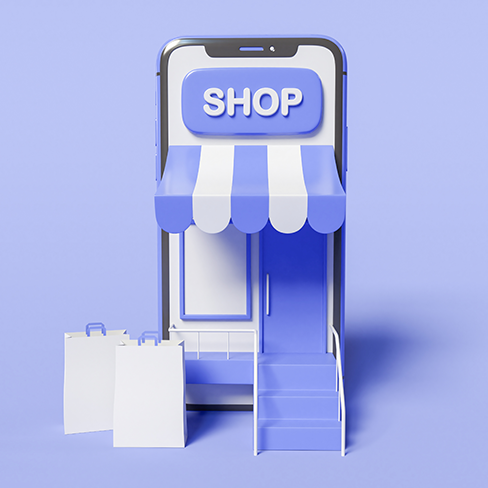
Precisely why the E-commerce chatbot script matters- is to make the chatbots more conversational, personalized, and empathetic. A good chatbot script could save your customer agents valuable time, reduce operational costs and give you scalable results.
Don’t take just our word for it, have a look at some stunning stats-
- 82% of consumers say that getting instant responses is essential when contacting brands.
- Chatbots will be responsible for cost savings of over $8 billion per annum by 2022.
- The adoption of chatbots will assist consumers and businesses to save over 2.5 billion customer service hours by 2023.
- Chatbots help 55% of companies generate high-quality leads.
- Chatbots increase website conversion rate by 33%.
What is a Chatbot Script?
A chatbot script is an outline determining the conversational flow between a user and a chatbot based on user intent, tone, context, and keywords. A well-formulated script ensures that the bot is personalized and can answer the questions promptly and correctly.
To help you get started building an E-commerce chatbot, here are 8 essential tips for writing an effective chatbot script
1. Scripts for Greeting New Visitors
The visitors that visit your page either already know your product or are keen on knowing it.
Why is a chatbot greeting script important, though?
The first thing visitors will see when they land on your page is your chatbot’s welcome message. Hence it is important that you draft the message with the utmost consideration for keywords and tones so as to convey your brand’s personality.
A greeting script should be short and concise such that it welcomes the user and makes them feel valued. It should be conversational and must include links to your blogs or products to carry forward the conversation without human intervention. Better bot experiences with more engaged audiences can generate response rates as high as 80–90%.
Another essential aspect of a greeting script is staying transparent and introducing your bot to your audience. Here’s an excellent welcome chatbot script example-
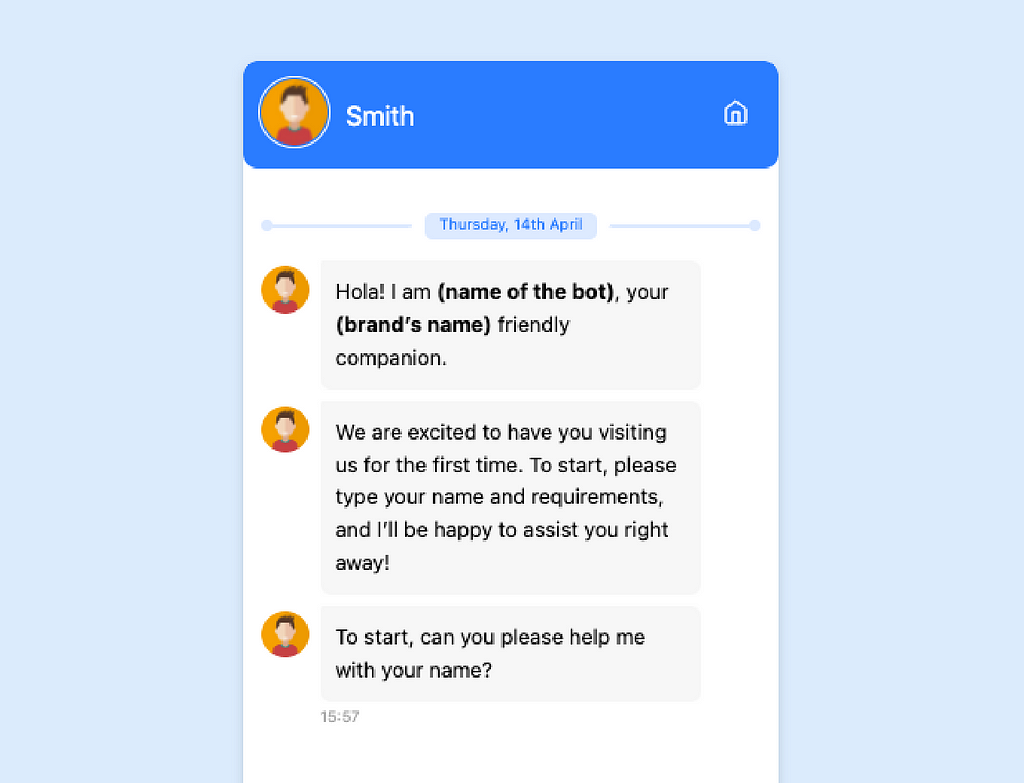
2. Scripts for Follow-ups
Online shoppers in the US are expected to reach 291.20 million by 2025. To make sure your sales are not thrown under the digital bus, it is important to strategically lure the users to trigger their desire and motivate them to purchase.
Follow-up chatbot scripts are the holy grail here. They are used to identify user pain points and address them, including but not limited to highlighting the product features, offering promotional discounts and free shipping, sending reminders, and showcasing positive feedback from the existing users. The underlying idea is to build an aura around the user’s mind about the product and motivate them to purchase.
Furthermore, since chatbots can analyze buyers’ shopping behavior and patterns, drafting a follow-up script based on the findings would be a wise decision.
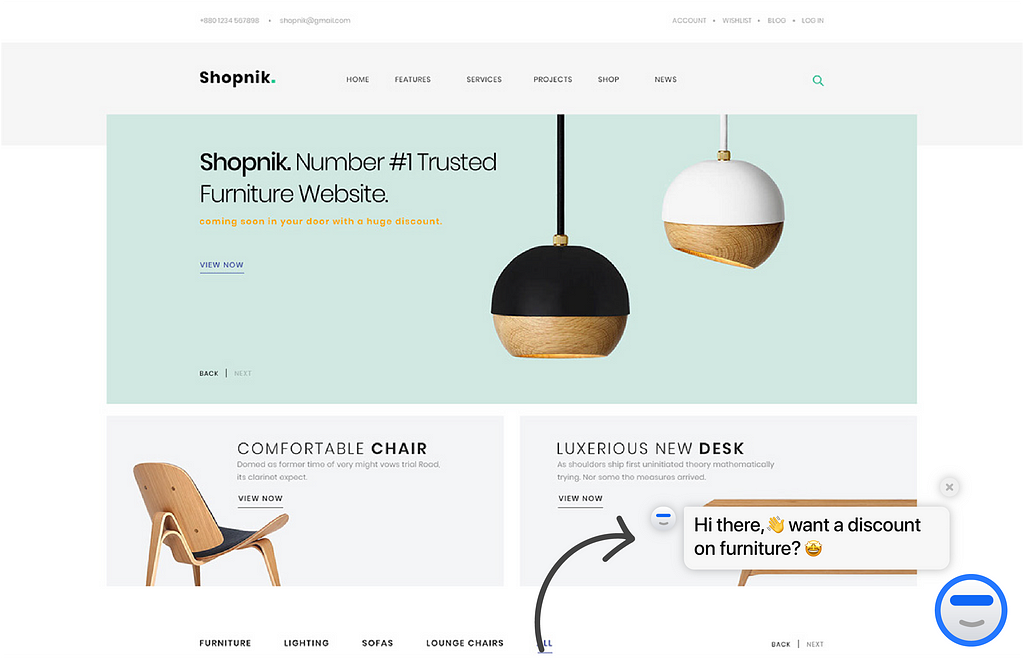
3. Scripts to Prevent Cart Abandonment
While the majority of online shoppers complete their transactions, there are some who navigate away before checking out their cart. According to statistics, the average cart abandonment rate on E-commerce portals in the US is as high as a whopping 69.82%. Users might leave the cart filled due to several reasons, including higher pricing, missing information, end-minute new information, etc.
These numbers suggest a considerable revenue loss to the business. E-commerce chatbot scripts can help!
Writing the script to remind the user that the cart has items pending for purchase and offering irresistible offers like huge discounts or free shipping as an incentive is one of the ways to stimulate sales. Secondly, to vacate the abandoned cart, the chatbot script should also engage with the user as much as possible.
Take the following chatbot script example:
Paul logs into his account on an E-commerce portal, add a belt and a wallet to his cart. He goes to the checkout page and finds a shipping fee of $50. When he doesn’t click on the pay now button, the brand’s E-commerce chatbot appears.
Chatbot: Hey Paul! You seem to have left items in your cart. Is there something I could help you with to complete the purchase?
Paul: A shipping fee of $50? It wasn’t mentioned earlier anywhere.
Chatbot: The shipping fee is a standard fee charged by the seller on COD orders. You can opt to pay at the time of checkout with reduced shipping of $5. Would you like that?
Paul: Yes, how should I change my payment mode?
Chatbot: I’ve made the edits, and now your prepaid order will cost you a shipping charge of only $5. Enjoy your shopping!
Notice how the E-commerce bot script referred to the user by their first name to create a personal touch. And how it was triggered at the right moment. The tone in the script was light, casual, and friendly, thus increasing Paul’s chances to continue the purchase.
4. Script for Customer Support
Customer Support is a common denominator amongst all industries. There is always the scope to automate the process, so having a customer support chatbot seems like a wise option irrespective of whatever industry you’re in.
With AI chatbots prevalent everywhere and in reach of every user, far-reached customer support could be provided by incorporating good, user-friendly scripts. This way, the users can seek details about the products and get answers to FAQs.
A customer support E-commerce chatbot script should be personalized to deliver the best conversational experiences. Secondly, the bot script must contain industry jargon and terminology- as it would build credibility for your chatbot. And lastly, keep the language as natural and fluid as possible and put some humor in your script so that the user gets a natural human touch. 58% of users say chatbots have positively changed their customer service expectations.
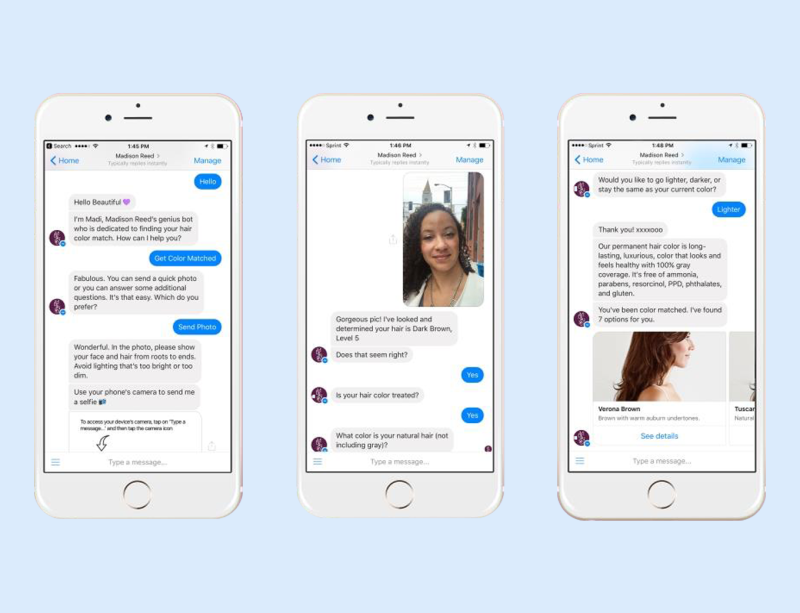
5. Scripts for Promotions
Approximately 40% of people of all ages prefer to use chatbots when shopping online. And an E-commerce promotional campaign is a good way to acquaint the users with a brand’s products. Chatbot interactions could be leveraged to ask users to subscribe, share their contact information or make purchases.
The users might share their contact information, for which case an E-commerce chatbot script should be designed to attract them to complete the purchase. It should include key details and USPs of the product, a FOMO (fear of missing out) factor. And in-app notifications (mentioned below) will make users more likely to buy the product.
“Don’t forget to buy the best (product name) at a 20% discount.”
or
“Only 3 days left till it ends.”
Remember to include a reasonable time in-between the messages to avoid spam.
6. Scripts for Cross-Selling
You don’t want your customers to purchase just one time, do you?
Therefore your E-commerce chatbot must keep the customers informed and engaged even after making their purchase. Chatbots steer conversations and result in demand generation.
The trick is to do it strategically via implementing a user-friendly and personalized script. Are you worried it might offend the customers? Well, more than 70% of customers are interested in hearing from retailers after purchasing, especially if they provide personalized content.
Let’s take the following chatbot example of an online clothing and accessory store. Notice how the chatbot script performs cross-selling by engaging the customer who has purchased a tunic.
Day 1: Hey There! It is a bright sunny day! Don’t forget to wear your blue daisy tunic today.
Day 2: The color and print of the tunic are perfect for a sunny day. Oh, and you can wear it at an evening soiree too. It’s a perfect dress, isn’t it!
Day 3: How about you accentuate your look with some cool summery sunglasses and a chic handbag?
7. Scripts for Order Placements and Returns
To make the whole shopping experience easier, you can enable users to buy products directly from your chatbot widget. The E-commerce bot script could be designed to provide product possibilities and the price. Once the user selects the product, he should be able to order directly from the bot.
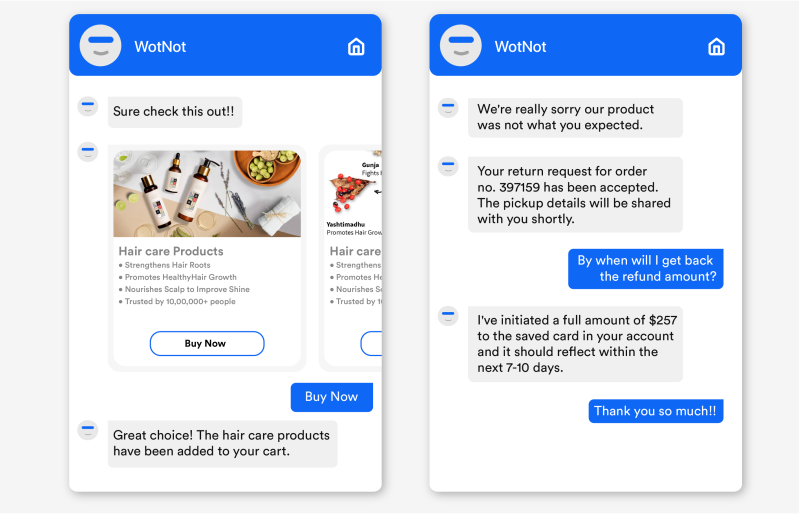
Secondly, implementing a chatbot for returning or exchanging the product also simplifies the process and enhances the user experience. The E-commerce chatbot script should allow users to return or exchange in a hassle-free manner, interact directly with the chatbot and receive status updates in simple text format.
8. Scripts for Customer Feedback
Getting the hang of how customers feel and view your products, services, and support is an invaluable asset for a business.
So, how do you collect customer feedback?
Forms over email?
Well, they have a 10% open rate and a less than 5% completion rate in the best of cases.
Can AI-written scripts help?
A. 100% yes.
Being conversational in nature, there is a good chance of customer interaction. The rule of thumb is to keep it simple. If answering the survey requires time and effort, customers might bounce off. The script should have options to the questions asked in the survey so that the customers don’t have to type anything.
Further, including GIFs, images, and color tones in the script will keep the customers more engaged, resulting in a successful survey.
Takeaway
Planning various chatbot scenarios and encompassing essential E-commerce chatbot scripts is essential for a good customer experience and sales boost. You need to trace customers’ buying patterns, identify their pain points, and then leverage them to create customized and personalized scripts.
If you’re wondering how to write a bot script, you don’t need coding. You can use the pre-designed chatbot templates or build your own message sequence.
Should you have some questions about how to write a bot script, reach out to us- we’re here to help!
Originally published at https://wotnot.io.
8 Essential E-commerce Chatbot Scripts For E-Commerce Website was originally published in Chatbots Life on Medium, where people are continuing the conversation by highlighting and responding to this story.
-
Integrate Zendesk Chat with Kommunicate Chatbot
As the world of customer service and support evolves, businesses are increasingly adopting a hybrid approach to support delivery, involving both automated systems and human agents. Organizations of all sizes must strike a delicate balance between auto-response systems and live human agents in today’s fast-paced digital landscape. Chatbots, on the other hand, are only as good as the conversations they’re programmed to have. And, the more your chatbot anticipates a question or resolves an issue, the better a support rep will be at directing users away from a bot conversation and into a human conversation. As a result, we’re at a loss as to how to improve their chat experience with a bot or even build one from scratch. In this blog post, we’ll go over how Zendesk Chat can help you improve your chatbot experience.
What is Zendesk chat?
Zendesk is an email-based ticketing system that helps businesses in tracking, prioritizing, and resolving support tickets. It can assist you in collecting customer requests submitted through various channels such as email, chat, social media, and chatbots and displaying them as tickets in a single dashboard. And using Zendesk Chat, also known as Zopim, you can instantly answer common questions and assist customers in submitting a ticket if their problem cannot be resolved right away.
Why do you want to integrate Zendesk Chat with Kommunicate?
Integrating Zendesk chat with Kommunicate will improve your team performance by taking advantage of features like:
- Live chat: Provide instant support to your customers with live chat wherever they visit your website from.
- Chatbot Builder: Using Kompose build and very own chatbot with no programming expertise
- Allow your agents to view the chat history and respond to tickets directly from the Zendesk dashboard.
How to integrate Zendesk Chat (Zopim) with Kommunicate?
To set up the Zendesk chatbot, we will need a conversation automation tool for customer support teams, such as Kommunicate, to help them automate repetitive requests and focus on more complex tickets. When you use a tool like Kommunicate, the process becomes much easier. To integrate Zendesk chat with Kommunicate, follow these step-by-step instructions.
Step 1: Retrieve Zendesk credentials
To begin, log in to the Zendesk dashboard and obtain the credentials listed below.
- Access Token — To obtain the access token, Go to the Zendesk admin centre and select the Zendesk API from the Apps and integrations category on the left panel. Choose an active API token from the list in the section. If you’re creating an API token for the first time, remember to enable and activate it.
- Subdomain — The subdomain can be found in the URL of the Zendesk account, for example https://yoursubdomain.zendesk.com.
Step 2 : Integrate Zendesk chat with Kommunicate
Voila! Start testing the Kommunicate chatbot, and the conversation will appear on the Zendesk chat dashboard once the integration process is complete. Agents can also respond to users directly from zendesk chat.

(PS: If you prefer to add chatbot directly from the Zendesk marketplace you can integrate Zendesk live chat with Kommunicate Chatbot within a minute).
Conclusion
With this integration, you can easily build a chatbot that can answer your customers 24×7. You can now use Zendesk Chat for handling & routing customer queries and Kommunicate for managing everything else like assigning conversations to agents, setting trigger & reply automation, etc.
At Kommunicate, we are envisioning a world-beating customer support solution to empower the new era of customer support. We would love to have you on board to have a first-hand experience of Kommunicate. You can signup here and start delighting your customers right away.
Originally published at https://www.kommunicate.io on April 14, 2022.
Integrate Zendesk Chat with Kommunicate Chatbot was originally published in Chatbots Life on Medium, where people are continuing the conversation by highlighting and responding to this story.
-
HR Chatbots: 5 Tips for Using Bots to Improve Employee Experience
5 Tips for Using Bots to Improve Employee Experience Artificial Intelligence (AI) advancements have given rise to AI chatbots, providing an innovative way to improve employee experience and human resources (HR) management.
A chatbot simulates conversation with human users, primarily over the Internet. While these conversational interfaces have existed since the mid-1960s in some form or another, today’s AI chatbots are smarter, more human-like, and more capable of understanding complex requests than ever before.
They can integrate with applications across several industries and have numerous business applications. With those kinds of benefits on the table, it’s no wonder HR departments worldwide are looking into how they can incorporate AI chatbots into their employee experience initiatives to improve engagement, efficiency, and productivity.
They want something faster and easier than filling out forms or calling an 800 number when you have questions about taking advantage of your benefits or how to file an employee complaint or any other HR-related issue.
If you are curious to learn about how AI chatbots can help HR in the workplace, read on for five tips on using chatbots to improve employee experience in the future.
Let’s first understand
What are Chatbots?
Chatbots have seen a significant increase in recent years mainly due to the rapid expansion of messaging apps such as WhatsApp and Facebook.
By chatbots, we mean computer programs designed to simulate human conversation. These programs are used to automate customer service or support tasks and can be found in various online applications and platforms.
Chatbots usually employ natural language processing (NLP) to interpret the user’s input and generate a response. This response can be in text, images, or even audio files.
Sometimes, the chatbot may also perform specific actions, such as booking a hotel room, ordering a pizza, or resolving queries of individuals.
Chatbots are used in various industries, including customer service, marketing, and sales. Many companies use chatbots to quickly and efficiently answer common questions from customers or prospects.
What are the Different Types of Chatbots?
1) Rule-based chatbots
Rule-based chatbots are powered by rules that dictate how the chatbot should respond to specific questions or queries. We typically use this type of chatbot for customer service or support purposes, where the bot can be trained to answer common questions or help customers with specific tasks.
Rule-based chatbots are usually created using natural language processing (NLP), allowing the bot to understand and interpret human language.
This is done using a combination of machine learning, which enables the bot to learn from and remember past interactions with users to improve its understanding of their queries over time.
Rule-based chatbots are often used for customer service because they can handle many customer inquiries.
Rule-based chatbots respond to specific questions or commands that are input by the user. They use a set of predetermined rules or algorithms to determine how to respond to a particular query to offer a tailored response that is accurate and relevant.
2) AI-based chatbots
Chatbots are becoming more and more popular as we can use them for various purposes, such as customer service, lead generation, and website navigation. AI-based chatbots can provide recommendations and suggestions to users.
Artificial intelligence and machine learning powers AI-based chatbots. This technology allows chatbots to understand natural language, making them capable of carrying on a human conversation.
AI-based chatbots are the future of customer service. With natural language processing and machine learning, they can understand customer inquiries and provide accurate responses.
They also learn from each interaction, so their responses improve. This makes them the perfect solution for businesses that want to provide excellent customer service without an extensive customer service team.
Let’s now look at the five tips for using bots to improve the employee experience.
1) Make sure your chatbot can handle a high volume of employees
Make sure your chatbot can handle a high volume of employees First and foremost, when you’re looking to improve employee experience with bots, it’s essential to make sure that your chatbot can handle a high volume of employees.
Depending on the size of your company, you may have hundreds or even thousands of employees constantly interacting with your bot. As such, your bot must be able to handle all those interactions without issue.
One way to ensure that your bot can handle a high volume of employees is to use a cloud-based solution. You can scale up or down as needed to ensure that your chatbot can always handle its demands.
Additionally, using a cloud-based solution will allow you to quickly and easily expand your bot’s capabilities if necessary.
2) Train your chatbot to recognize common HR questions and provide an accurate answer
When using bots to improve employee experience, it’s essential to train your chatbot to recognize common HR questions and provide accurate answers. This will ensure that your employees can get the information they need quickly and easily.
For example, a bot could be trained to recognize commonly asked questions like When is my next paycheck? or What time does my shift start? Once your bot has recognized a question, you can program it with an appropriate answer that will help you manage your employees easily.
Remember, if your HR chatbot will be helpful, it needs to know how to handle different types of questions! If a user asks when their next paycheck will arrive but doesn’t specify whether they’re referring to hourly pay or salary pay, the bot should know how to clarify what type of pay period is being referred to.
Once you’ve trained your HR chatbot with these kinds of follow-up questions, you’ll find that employees are more likely to use it because they feel like they’re getting an answer tailored specifically to them. This also means that you’ll have fewer employee complaints coming in.
3) Design your chatbot to be user-friendly and easy to navigate
Make sure your chatbots are easy to understand and navigate. The buttons and links are easy to find, and the chatbot provides clear instructions on how to use them.
It should have important information that is easily accessible and allows users to find the help they need easily. You can also design your chatbot to mimic how people talk to feel more natural and user-friendly.
Test it with a small group of employees before rolling it out company-wide. And be prepared to troubleshoot any glitches to address them quickly and keep your chatbot running smoothly.
Provide training on how to use your HR chatbot. Train everyone who will use your HR chatbot. This will help ensure that everyone knows how to navigate it and what information is available.
4) Enable employees to communicate with the chatbot in their preferred language
Enable employees to communicate with the chatbot in their preferred language By enabling employees to communicate with the chatbot in their preferred language, you can ensure that all employees feel comfortable using the chatbot and that they can get the help they need in a language they understand.
This will improve the employee experience by providing a communication channel that is highly convenient and accessible.
Communicating with the chatbot in their preferred language makes it easier to ask questions and get answers. The chatbot can also provide employees with information about their benefits, payroll, and other topics related to their employment. This helps employees stay informed and up-to-date on the latest changes within the company. They are more likely to use it and share feedback about their experience.
You can use this as a way of gathering employee sentiment regarding changes within your organization, new benefits, and HR processes that have been implemented for the betterment of the organization.
5) Use chatbots to automate simple HR tasks
Chatbots can help automate simple HR tasks, freeing up your team to focus on more important tasks.
If you have simple HR tasks that need to be completed regularly, chatbots can be a great way to automate them. This will free up your team to focus on more important tasks and make your lives easier.
By automating some of your daily tasks, you’ll also reduce error rates and improve the employee experience. The key is knowing which tasks are best suited for automation with a chatbot and how to use them effectively.
Chatbot technology is constantly evolving. If you’re considering using chatbots in the workplace, it’s important to know what’s available and how they can be used effectively so that a new process doesn’t overwhelm your team. In order to use chatbots effectively, you need to make sure that your employees are comfortable with them and know the optimal way to use them properly.
You can also use AI powered facial recognition attendance system and employee monitoring software that allows to automatically track employee attendance and keeps track of your employees’ productivity automatically through an online dashboard or mobile app.
Conclusion
Chatbots are one of the most popular ways to interact with customers, and they can be used to great effect in the employee experience. In this blog, we’ve outlined five tips for using chatbots to improve the employee experience. We hope you find these tips helpful and that you consider using chatbots in your own organization.
We’d love to hear your thoughts. Hit us up in our comments section. We’re always open to suggestions!
We will catch up with you soon.
Until then, keep reading and keep exploring.
Thank You !!.
HR Chatbots: 5 Tips for Using Bots to Improve Employee Experience was originally published in Chatbots Life on Medium, where people are continuing the conversation by highlighting and responding to this story.
-
How to create a Facebook Messenger Chatbot in 2022
One of my cousins just graduated from high school and was looking for some career advice. He told me about an experience he had on Facebook when he set out to understand what to consider as a career.
He came across a university page and decided to have an interaction with a messenger bot. It guided him to his ideal course of study and gave answers to all possible questions in a few minutes. It was a great experience as he could understand everything about his options within an hour. Outstanding is what he told me when he completed sharing the story with me.
Thus having a super active customer support team is crucial for fast-growing organizations to succeed. However, before we jump on the detailing of chatbots, let us first understand what it actually is?
What is a Facebook Chatbot?
A chatbot is an AI conversational program that you can use to chat with your customers/visitors on your behalf with pre-programmed responses. The conversation happens on Facebook-based platforms like Messenger. It aims at helping users with the necessary support in seconds.
How to Create Facebook Chatbot
Step1: The first thing you must do is create a Kommunicate account.
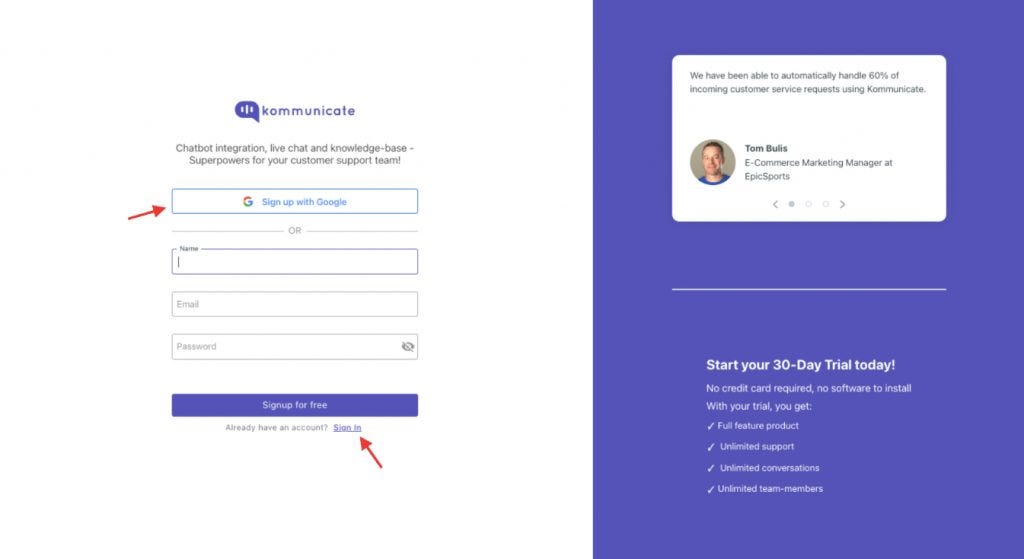
Step 2: Now create the chatbot that you will use on your Facebook Fan Page.
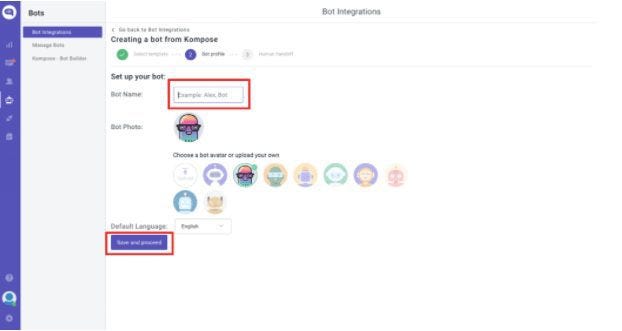
Step 3: Create your first welcome message that people will see after pressing the Messenger button from your Fan Page.
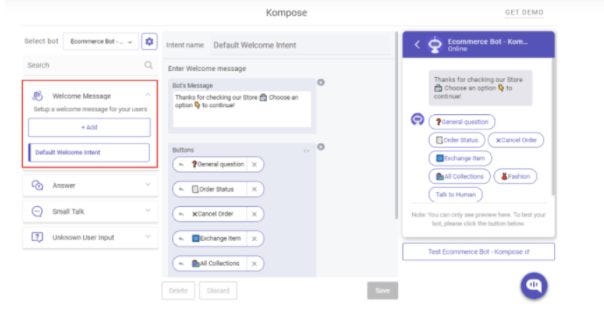
Step 4: Set your created chatbot to handle all your customer conversations in Facebook messenger.
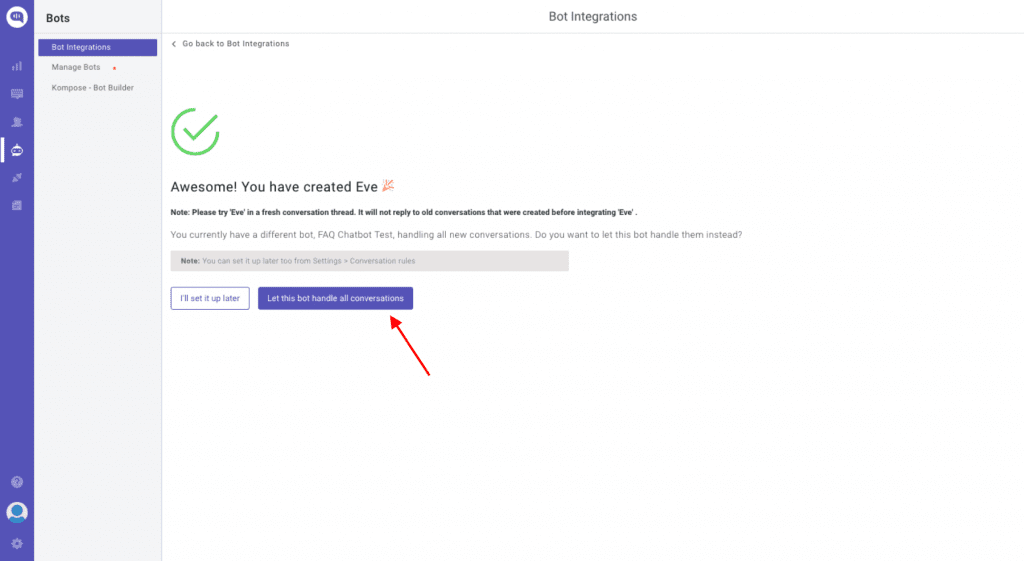
Step 5: Click on “ Integrated to Facebook “ to connect it to your Fan Page.
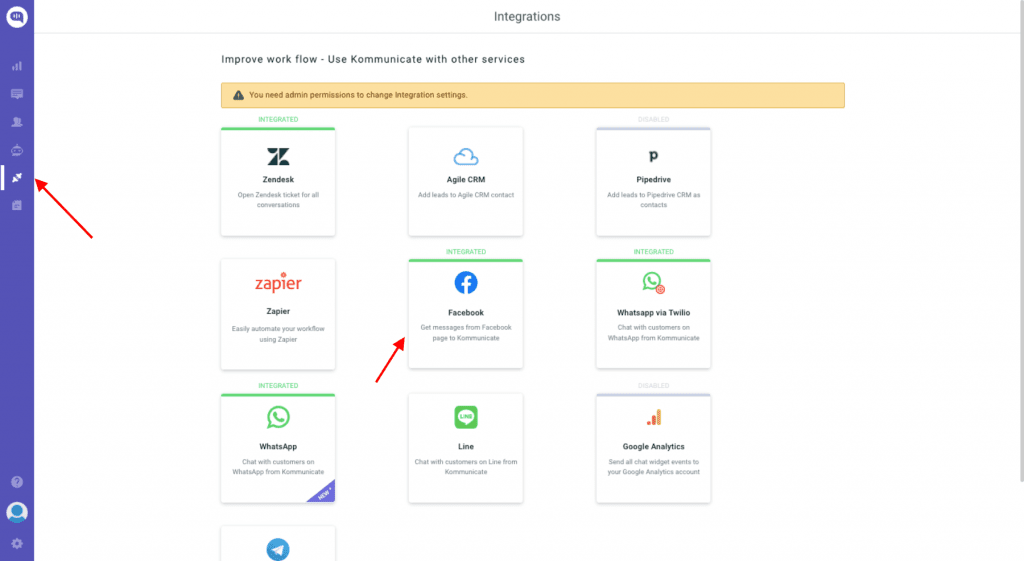
Step 6: Once you click on Settings, a pop-up will come that requires you to login on to your Facebook fan page. And log into your Facebook account
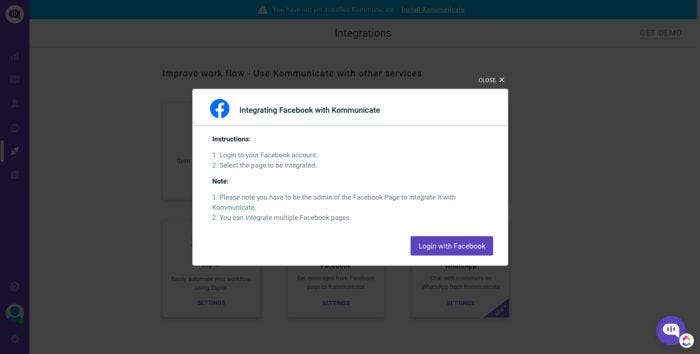
Step 7: Select the page or multiple pages that you want to integrate.
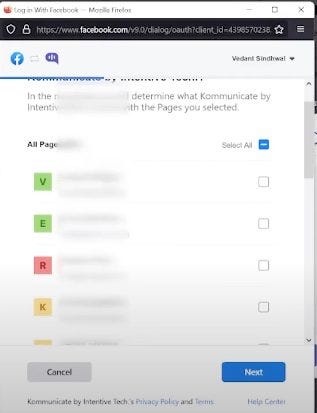
Step 8: Check on all the permissions, and then click done now.
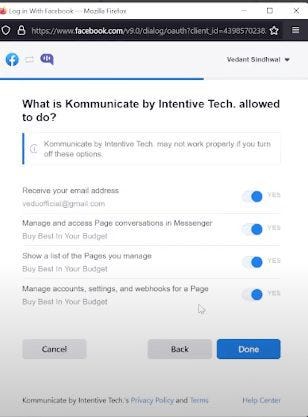
Step 9: You’ve successfully integrated Facebook with Kommunicate.
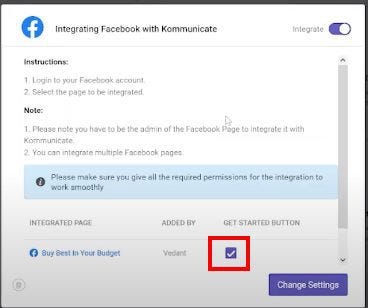
Step 10: Test whether the integration was successful.
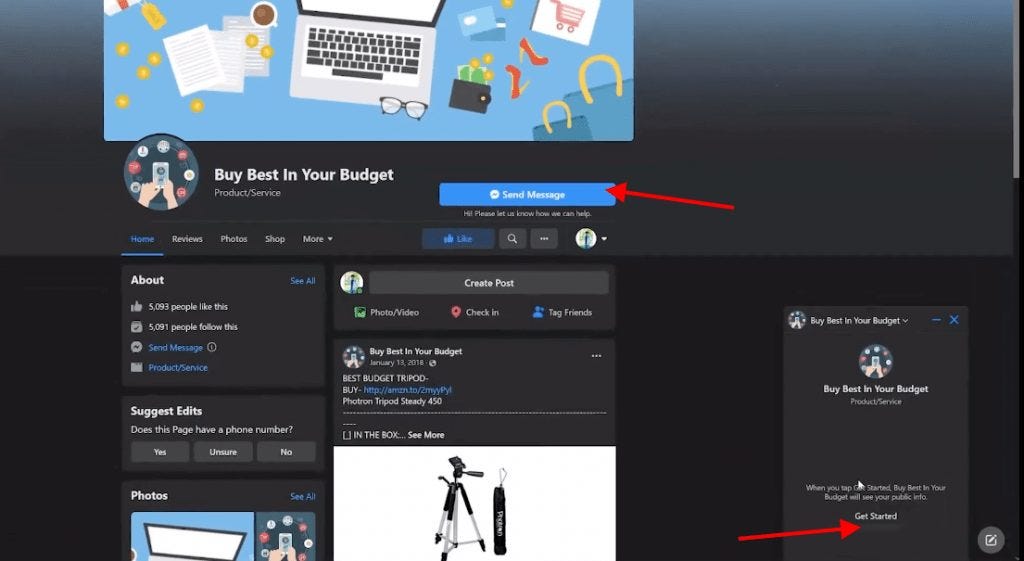
Step 11: You can see all these messages from your Kommunicate conversation dashboard as well. Your Chatbot can transfer the conversation to a human team member when it is unable to recognize
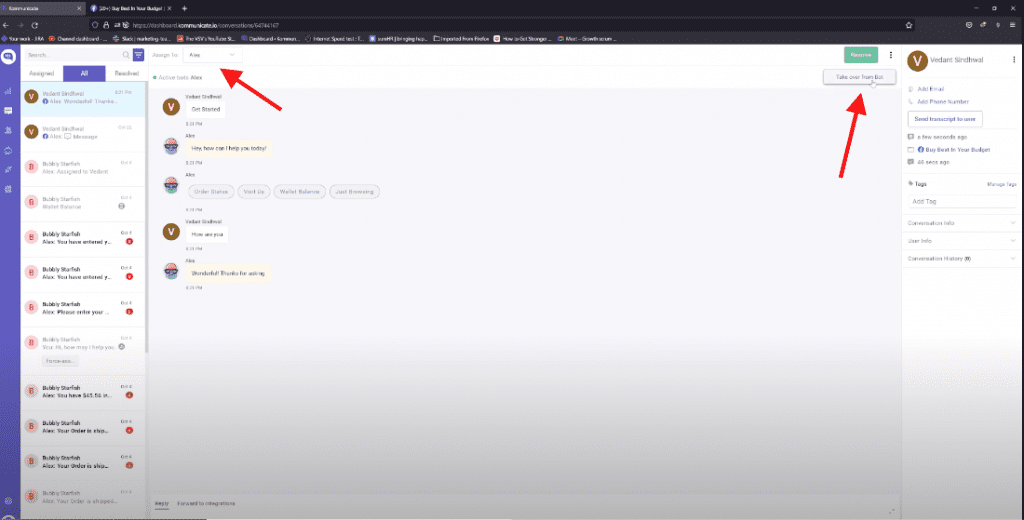
At Kommunicate, we are envisioning a world-beating customer support solution to empower the new era of customer support. We would love to have you on board to have a first-hand experience of Kommunicate. You can signup and start delighting your customers right away.
Originally published at https://www.kommunicate.io on April 23, 2021.
How to create a Facebook Messenger Chatbot in 2022 was originally published in Chatbots Life on Medium, where people are continuing the conversation by highlighting and responding to this story.
-
Revamp Your Website With 3D Avatars

Life is not two-dimensional, why should your website be?
If you have an amazing product or service, it’s time to let that be known through easy-to-build 3D avatars for your website.
Bot Libre provides complementary support for creating, using, and embedding web avatars to your website. A web avatar is your website’s visual or animated web presence.
Bot Libre avatars contain 3D animation, video, audio, and images. You can create your avatar or choose a shared avatar from the Bot Libre open avatar directory. Avatars can either be connected to your Bot Libre bot, controlled directly through JavaScript, or even connected to your homegrown bot, or third-party bot.
The Bot Libre JavaScript SDK makes it easy to add an avatar to your website or blog, welcome your website visitors, or provide them with information or help. A website avatar gives visitors to your website a good first impression, can highlight important differentiators of your business, or draw attention to special offers.
Embedding An Avatar
You can browse existing avatars or create your own from Bot Libre’s open avatar directory. To embed an existing avatar simply select the avatar from the browse directory and click on the Embed button. The embed page will let you test the avatar, choose its voice, enter what to say, and generate the embedding JavaScript code. Then copy the embedding code and paste it onto your website.
Example
<script type=”text/javascript” src=”scripts/sdk.js”></script>
<script type=”text/javascript”>
var sdk = new SDKConnection();
sdk.applicationId = “{your app id}”;
var web = new WebAvatar();
web.connection = sdk;
web.avatar = “Julie3”;
web.createBox();
web.message(“Welcome to Bot Libre”);
</script>
The example shows how to use the WebAvatar class and its create box() function to add an avatar to a web page. The message() will make the avatar speak the text, and can optionally include an emote, action, and pose. The emotion and pose influence which video or image will be displayed, the action can trigger an image or audio. You can also choose the voice for the avatar.
When using the SDK ensure you set your application id. You can obtain your application id from your user page, it is free and easy to generate.
Connecting Your Bot To An Avatar
To connect your bot to an avatar, go to your bot’s main page. Click on the Admin button and the Avatar link. When you click on the Choose Avatar input, a list of available avatars will be presented for you to select from. If you want to create your avatar, you can create one from the Avatar browse page. If your bot has an old image avatar, or you just want a simple image avatar, you can click on the 1.0 avatar link.
Once your bot is connected to its avatar, you can link phrases or responses to avatar emotions, actions, and poses. You can teach the bot to associate emotions and actions with phrases and responses when chatting with it in learning mode. The emote and action dropdowns in the chat page can be used for this.
The Training & Chat Logs page under your bot’s Admin page lets you review and edit all emotions, actions, and poses that have been associated with phrases and responses, or add new ones.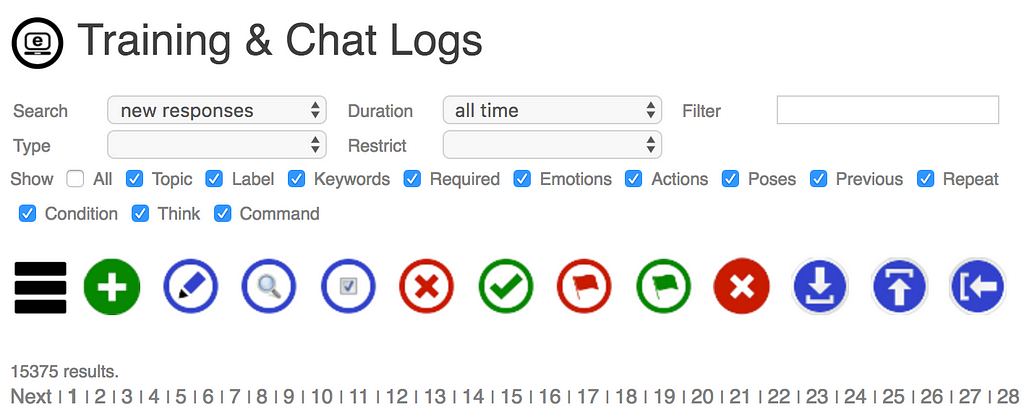
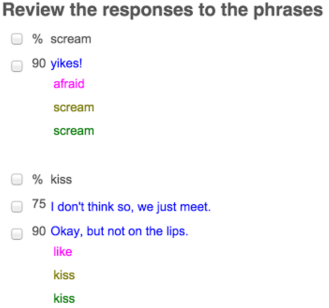
Creating Your Own Avatar
You can create your avatar from the browse avatars page. To create an avatar, just give it a name, description, and category to categorize it under. You can either make the avatar private and choose who can access it, or make it public and accessible by anyone. You can also choose what license you wish to release its content under.
To edit the avatar, click on the Editor button. The avatar editor lets you import video, audio, and image files. You can associate each media with an emotion, action, or pose. For example, if you have a video that makes the avatar talk, you would associate the pose for the video with talking. The emotions let the avatar express different emotions, and will let the bot using the avatar express itself. There are a fixed set of emotions, but you can create any actions and poses that you wish. You can have multiple media for emotions, action, or pose, and one will be chosen at random. For actions, and poses, you can have an audio element in addition to a video element. Audio can be used to make your avatar perform actions such as laugh, or used as background music or noise for a pose.
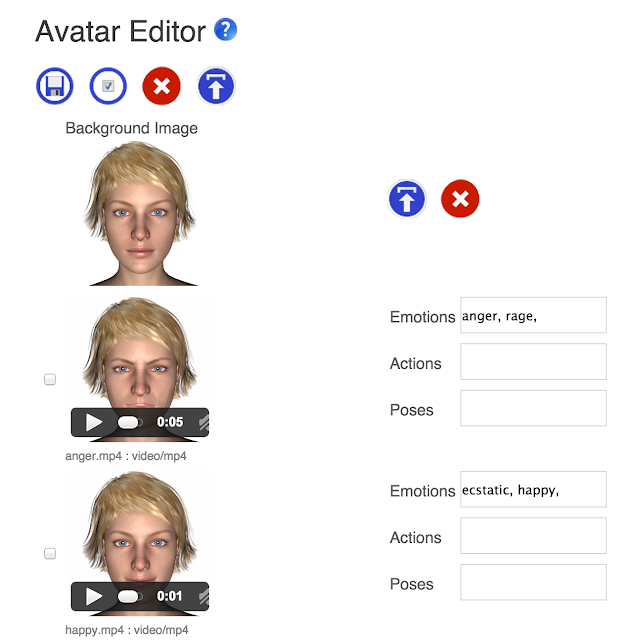
File Formats
Your video files can be any valid web video format, including mp4, WebM, or Ogg. Audio files can be any web audio format, such as mp3, or wav.
Creative Freedom
You can create your media content using stock content from media websites such as Fotolia, or free media libraries like openclipart.
You can use 3D software such as Daz3D to generate images and videos for your avatar. You can use available 3D models, or buy stock 3D models from 3D media marketplaces.
You can bot yourself, a friend, or a model by capturing photos, or video clips using your phone, or camera. If you are adventurous, you can use a green screen (a green sheet will do) to make a transparent background for your media.
If you are an artist, model, or studio, you can make your images, 3D models, and video, then Bot Libre can showcase or sell your media and talent.
Video Types And Browser Compatibility
Avatars can include several types of media. Simple image avatars are the most compatible with all browsers. Video avatars require the browser to support HTML5 video, which most modern browsers do. There are several web video formats, including mp4, WebM, and Ogg.
The mp4 video format is the most compatible with all browsers and works in the latest Firefox, Chrome, Internet Explorer, and Safari browsers.
The WebM format has the advantage of supporting transparent backgrounds but is only currently supported by Chrome and Firefox, and only Chrome supports transparency. Chrome is the most popular browser for most websites, Firefox is normally second, then Safari, Internet Explorer, and other browsers. If browser compatibility is important to your website you can use JavaScript to choose your avatar based on the browser.Custom Avatar Design
We can custom design your avatar through our avatar service. You can choose any Daz3D models, or we can create a 3D model from a passport-style photo of a face. For your custom avatar upgrade to our Platinum or Diamond service or contact sales@botlibre.biz .
Revamp Your Website With 3D Avatars was originally published in Chatbots Life on Medium, where people are continuing the conversation by highlighting and responding to this story.
-
Call Center Sentiment Analysis — Hack to Empathetic Customer Service
Call Center Sentiment Analysis — Hack to Empathetic Customer Service
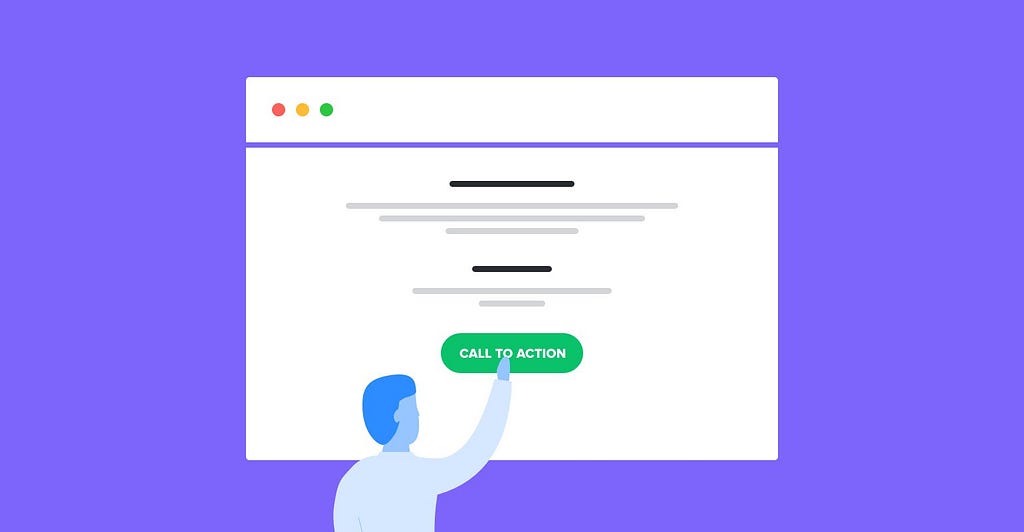
Call Center sentiment analysis is the processing of data by identifying the natural nuance of customer context and analyzing data to make customer service more empathetic.
If you are employed in Call Center, the following scenario might be familiar: You get a call from a client and hear their words with stress. The cause for such a cataclysmic reaction: They got a bad rating for their products or business.
Some of those reviews might be negative, formal, and neutral. Knowing what someone meant can be tricky unless you understand their emotional quotient.
Although, most call center organizations rely on common processes such as surveys and groups to understand the customer context and choice. These processes and tools might help you gain some traction from customers but won’t be fruitful in the long run.
The problem persists that how you are providing a significant customer experience. As a torchbearer of technology Sentiment Analysis has the potential to enable call center managers to learn what their customer wants and provide an empathetic customer experience.
What are Call Center Sentiment Analysis and its importance?
Call center sentiment analysis is the processing of collecting, analyzing, and taking action on customer response. As per “ The use of Sentiment Analysis is one of the top technologies trends that will have the greatest impact on customer service in the future. “
Sentiment analysis is a powerful tool that produces data by identifying nouns, verbs, adjectives, and adverbs in voice or text and interpreting the sentiment behind it.
Call center managers can mine this data by using Artificial Intelligence (AI) technologies like Machine Learning(ML), and Natural Language Processing(NLP). By using these cognitive capabilities, the sentiment analysis algorithm helps the call centers determine whether the process data express a positive, negative, or neutral tone.
In the customer center, the main aim is to have maximum insight into customer intent. Sentiment analysis enables call center agents to tailor their branding and business management to be more engaging and empathetic. This not only enhances customer loyalty but also improves human-to-human customer support outcomes.
Customer Sentiment Analysis Benefits
It’s no surprise that many businesses and organizations are using sentiment analysis to revive their customer experience.
Let’s dig into the advantages of sentiment analysis in call centers-
Machine learning algorithms, sentiment analysis keeps learning from past interactions and recommends products and services as per customer’s interest, therefore providing a personalized customer experience.
Customer requirements and needs vary from customer to customer. And in the era of instant everything customers expect the same from call center agents. With sentiment analysis generated , call center agents can review data in real-time, and assess whether the customer is feeling positive or negative. This in turn helps them reduce call handles time, cuts costs, and enhances customer loyalty in their services.
Customer experiences are hampered by the lack of emotional cues, raising barriers to communication. But, call center sentiment analysis enables agents to see through the true intent behind customer emotion. By using deep machine learning, it automatically detects positive or negative intent behind customers’ emotions and helps call center agents to interact with them accordingly.
The more you improve service quality, the more loyal your customer base. But how do you know where improvement is required? With predictive algorithms and AI capabilities, sentiment analysis can parse through the negative and positive emotions of customer feedback. That’s how it makes call center agents be self-aware about the changing pattern in their customer service and make changes before it reaches a critical stage.
Companies using sentiment analysis makes a lot of difference in the way they interact with their customer. Sentiment analysis constantly checks the customer pulse by using AI algorithms and provides practical insights into differences in the nuanced and contextual tone and emotion of customer speech for faster resolution.
Conclusion
The importance of call center sentiment analysis has accelerated in the new normal. There is no formula to prevent negative and neutral feedback from the world out there. However, your company will be better equipped to respond if it implements a strategy that leverages sentiment analysis.
From identifying happy customers to negative feedback, sentiment analysis enables companies and organizations to truly stay competitive and on top of their game. All your organization need is to embrace the change.
Follow Techdee for more!
Originally published at https://www.techdee.com on January 26, 2022.
Call Center Sentiment Analysis — Hack to Empathetic Customer Service was originally published in Chatbots Life on Medium, where people are continuing the conversation by highlighting and responding to this story.
-
Automatic Speech Recognition (ASR)- Building Future Ready Workplace
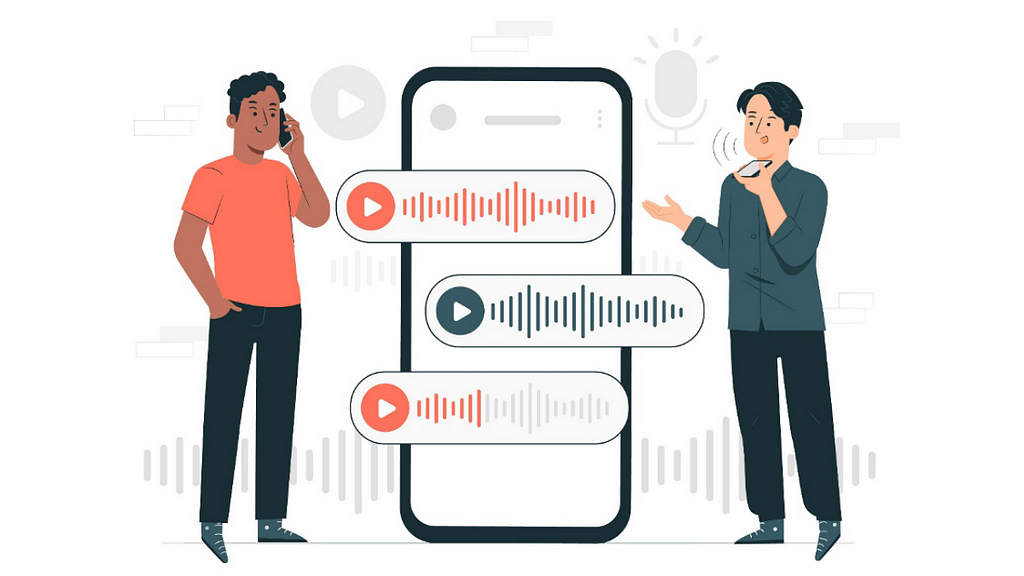
We can trace the advancement in technology adoption from punch-card computers to the latest touch screen devices. However, there is a lot left to explore. But, what is it?
The answer is Automatic Speech Recognition (ASR). It is a huge step to transform the spoken word into written form. Automatic Speech Recognition (ASR) is a trend that is set to make noise in 2022. And the rise in the growth of voice assistants is due to in-built voice assistant smartphones and smart voice devices like Alexa.
As per PwC, 29% of customers leverage voice assistants to ask quick questions.”
Considering the benefits Automatic Speech Recognition (ASR)(ASR) brings, there is the wellspring of an opportunity here and now for business savvy people and digital innovation leaders to put ASR to good use.
Before we dig down to the use cases, let’s first understand the basics.
What is Automatic Speech Recognition (ASR)?
According to Microsoft, around 35%of respondents use a smart home speaker to engage with speech recognition assistants.
In simple words, Automatic Speech Recognition primarily focuses on translating verbal speech into text and seek to identify individual users’ voice. For example, if human spells, “ Hey Google, what is the weather like today?” your smartphone will convert the speech into text and reply after pulling data from the internet.
And the more advanced version of ASR communicates with customers in a genuinely human-like way by using AI and Machine Learning.
These advanced ASR systems can also integrate grammar, syntax structure, and composition of audio and voice signals to interpret and process verbal speech into text.
Moreover, they evolve with each passing interaction and enable organizations to adapt and customize their technology as per business requirements.
How Does Automatic Speech Recognition (ASR) work?
The basic Automatic Speech Recognition (ASR) system receives the audio input from a person speaking. Then, it processes the information by breaking down various components of speech and transcribes the speech into text.
Instead of coding rules for translating speech onto text, enterprises can build their neural network by feeding audio datasets into algorithms that easily mimic human brain architecture. Automatic Speech Recognition (ASR) comprises of three steps process-
This step involves decoding both spoken language and written vocabulary fundamental elements. It ensures the accuracy of speech recognition datasets that have extensive vocabularies.
Once speech decodes, the acoustic model separates audio signals into smaller frames and aims to predict which sound is spoken in each frame using different phonemes. The acoustic model used Machine Learning datasets to train various audio recordings and relevant transcripts to determine phonemes used in a particular audio frame.
The last step in the ASR process includes using data collection and Natural Language processing to understand the human context and make close to accurate predictions about the words and sentences from the audio input.
Automatic Speech Recognition (ASR) Examples
With an influx of callers, organizations must have the support to resolve queries in real. Using Automatic Speech Recognition (ASR), call centers document customer calls and provide them quick resolution. IVR bots limit manual intervention by resolving routine queries and enabling agents to handle complex tasks. If the bot cannot resolve questions, the call can be diverted to live human agents with transcribed customer’s phone screen.
As per the Juniper report, digital voice assistants usage will be 8 million by 2023, driven by smart home devices. Using Conversational AI capabilities, voice assistants help process tasks like opening the mobile app, navigating maps, sending text messages, and searching on the browser seamlessly without a glitch.
Using language learning through Automatic Speech Recognition (ASR) breaks down the language barrier and makes travel and cross-border communication accessible. Automatic Speech Recognition (ASR) datasets also help students engage in self-guided language study. ASR system listens to the voice input analyzes it to perform a match/mismatch. Once identified, it corrects the pronunciation and informs the students.
Transcriptions is one of the widespread use cases of Automatic Speech Recognition (ASR). From transcribing lectures to zoom calls and webinars, the ASR system provides a level of convenience and accessibility to audio and video accessibility. In addition, the ASR system also offers the transcription of live podcasts and webinars, which allows the broader audience to access media efficiently.
Join the Force with Automatic Speech Recognition (ASR)
Despite the advancement Automatic Speech Recognition (ASR) brings, there is a long road to digital transformation. In the digital era, organizations strongly feel customer experience holds the utmost experience to generate higher ROI. And Automatic Speech Recognition (ASR) is the quick fix to create a personalized experience and allow real-time interaction. Simply putting computers to listen, Automatic Speech Recognition (ASR) limits the manual intervention and enhances employees and customer engagement. The time is now to unlock the power of Automatic Speech Recognition (ASR), soo what you are waiting for.
Originally published at https://www.imcgrupo.com on April 14, 2022.
Automatic Speech Recognition (ASR)- Building Future Ready Workplace was originally published in Chatbots Life on Medium, where people are continuing the conversation by highlighting and responding to this story.
-
Add AI Powered Chatbot to Your Shopify Store
Shopify is one of the most widely used e-commerce platforms that have helped many businesses globally to go online by building their marketplace. It’s used by more than 800,000 vendors worldwide. While the customer is the pivot around which the eCommerce business works, it is essential to have effective customer engagement to enhance their experience and improve overall sales. This is where the Shopify bot comes in handy.
Bots have played an instrumental role in addressing the customer’s queries and converting them into active sales. Due to limited person power and the ever-increasing volume of customers in e-commerce stores, it is impossible to keep up without automation, AI and chatbots.
Benefits of Shopify ChatBot
In the e-commerce world, bots are bringing about a transformation. They are recreating the user experience with businesses and replacing it with an experience they have with friends. Some of the benefits of Shopify chatbots include,
- 24×7X365 support, they do not go on holidays
- Resolving queries
- Personalization
- Reduced costs
- Product guidance and onboarding
- Generating leads
- Driving sales
Now that we have concluded e-commerce stores need chatbots, let’s jump into making AI bots and deploying them on Shopify websites.
You can also directly install kommunicate chatbot from Shopify app store.
Setup & Activate Chatbot for Shopify
Step 1: Setup an account in Kommunicate
We will be using Kommunicate’s bot builder and chat UI plugin for this example. First, login to your Kommunicate dashboard and navigate to the Bot Integration section.
If you do not have an account, you can create one here for free.
Locate the Kompose section and click on Integrate Bot. Kompose is Kommunicate’s AI-powered bot builder.

Now, set up your bot by providing the bot name, bot language, and human handoff setting, and finish the bot setup.
Additionally, Kompose has an in-built e-commerce bot template that you can use. It has multiple intents related to Shopify store operations such as order status, product catalogues, recommendations, FAQs, etc.
You can check your newly created bot in the below section:
Step 2: Create welcome messages & answers for your Shopify Chatbot
Go to the ‘Kompose — Bot Builder’ section and select the bot you created.
First, set the welcome message for your bot. The welcome message is the first message that the bot sends to the user who initiates a chat.

After creating the welcome message, the next step is to create possible questions and answers for your Shopify bot.
The answers section is where you’ve to add all the user’s messages and the bot responses.
In the Configure user’s message section — you need to mention the phrases that you expect from the users that will trigger.
Configure the bot’s reply section — you need to mention the responses (Text or Rich messages) the bot will deliver to the users for the particular user’s message. You can add any number of answers and follow-up responses for the bot.

You can also refer to this blog or the video below for Kompose bot integration with Kommunicate.
Step 3: How to activate the chatbot?
Once you create a bot, then you can set it as a default bot in the conversation routing rules section, as shown below.

We have completed the bot setup. Now, this bot will reply in all the conversations. Next, let’s jump into deploying the bit on your Shopify store.
Add Chatbot to Shopify Websites
Step 4: Install Kompose bot into Shopify
Login to the Kommunicate dashboard. Navigate to the Install section under ⚙️ Settings, where you will get the live chat plugin script. Copy the script.

Step 5: Log in to Shopify
Log in to your Shopify account. Click on Online Store.

Step 6: Edit code
Navigate to the Themes section. Click on the Actions button and then click the Edit Code option.
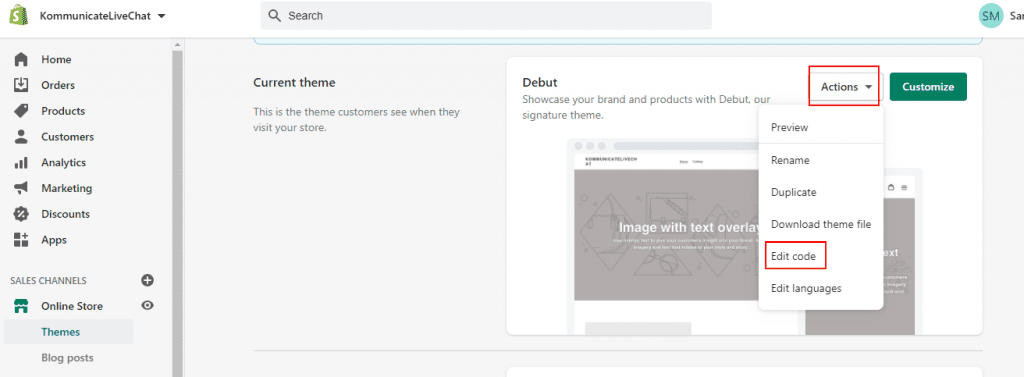
Step 7: Add a Live-chat script
In the Edit Code section, go to the left side Edit Code for Debut panel and click on Sections.
Open the footer. liquid section and paste the copied live-chat plugin script just below </footer> tag. Click on Save.

Step 8: Preview & Publish
After saving, click on Preview to see the changes. You will see the chat widget on the bottom right corner of the Shopify website.

Here’s a video to walk you through the Shopify integration with Kommunicate:
Wrapping Up
That’s all! In these easy steps, you can install the chatbot on your Shopify website. You can use your newly created Shopify chatbot to improve customer support, customer experience, and lead generation.
Kommunicate helps companies to automate customer support and reduce costs with the use of the human + chatbot hybrid model. You can signup and reduce your customer support cost right away.
Originally published at https://www.kommunicate.io on July 17, 2021.
Add AI Powered Chatbot to Your Shopify Store was originally published in Chatbots Life on Medium, where people are continuing the conversation by highlighting and responding to this story.
